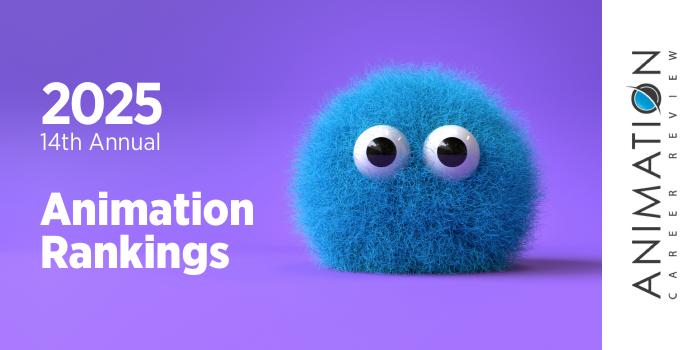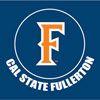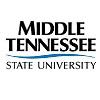
Become a 3D animator for film and games! Get specialized training to fast-track your career with CG Spectrum’s online 3D animation courses. Learn directly from expert animators working on hit films and best-selling games. Find out more.

| Ranking | School | State | % |
|---|---|---|---|
| 1 | University of California, Los Angeles | California | Top 1% |
| 2 | Texas A&M University | Texas | Top 2% |
| 3 | The Ohio State University | Ohio | Top 3% |
| 4 | University of Central Florida | Florida | Top 4% |
| 5 | University of Texas at Dallas | Texas | Top 5% |
| 6 | San Jose State University | California | Top 6% |
| 7 | Massachusetts College of Art and Design | Massachusetts | Top 7% |
| 8 | Purdue University | Indiana | Top 8% |
| 9 | Arizona State University | Arizona | Top 9% |
| 10 | California State University, Fullerton | California | Top 10% |
| 11 | Florida State University | Florida | Top 15% |
| 12 | Clemson University | South Carolina | Top 15% |
| 13 | University of Florida | Florida | Top 15% |
| 14 | California State University, Long Beach | California | Top 15% |
| 15 | University of Colorado, Denver | Colorado | Top 15% |
| 16 | University of North Carolina School of the Arts | North Carolina | Top 20% |
| 17 | New Mexico State University | New Mexico | Top 20% |
| 18 | Middle Tennessee State University | Tennessee | Top 20% |
| 19 | Fashion Institute of Technology | New York | Top 20% |
| 20 | University of Washington | Washington | Top 20% |
| 21 | California State University, Los Angeles | California | Top 20% |
| 22 | Ball State University | Indiana | Top 25% |
| 23 | University of Utah | Utah | Top 25% |
| 24 | North Carolina State University | North Carolina | Top 25% |
| 25 | Sam Houston State University | Texas | Top 25% |
| 26 | Louisiana State University | Louisiana | Top 25% |
| 27 | Bowling Green State University | Ohio | Top 30% |
| 28 | University of South Florida | Florida | Top 30% |
| 29 | East Tennessee State University | Tennessee | Top 30% |
| 30 | Kennesaw State University | Georgia | Top 30% |
| 31 | California State University, Northridge | California | Top 30% |
| 32 | University of Illinois at Chicago | Illinois | Top 35% |
| 33 | Ohio University | Ohio | Top 35% |
| 34 | Virginia Commonwealth University | Virginia | Top 35% |
| 35 | University of Wisconsin – Stout | Wisconsin | Top 35% |
| 36 | Ferris State University | Michigan | Top 35% |
| 37 | University of Connecticut | Connecticut | Top 40% |
| 38 | Indiana University, Indianapolis | Indiana | Top 40% |
| 39 | Utah Valley University | Utah | Top 40% |
| 40 | University of South Carolina | South Carolina | Top 40% |
Our 2025 list -our fourteenth annual- of the Top 40 Public Animation School Programs in the US.
For an explanation of ranking criteria, click here.

University of California Los Angeles (UCLA) is home to the School of Theater, Film and Television (TFT), which serves approximately 680 students enrolled 15 programs leading to an undergraduate or graduate degree. At the undergraduate level, the School of TFT has a Film, Television, and Digital Media BA (FTVDM-BA) program with a concentration in Animation.
During the first and second years of the program, students focus on foundational courses. In the third year, students will hone their skills in television, film, and digital media production. In the final year of the program, students will immerse in the Animation concentration, consisting of 20 units of upper division coursework.
The UCLA Film, Television and Digital Media BA culminates with a professional internship and final project. Graduates are prepared to pursue careers in the entertainment industry or apply to the UCLA Animation Workshop.
Established in 1948 by Disney Animator William Shull, the workshop launched an Animation MFA program when UCLA TFT graduate Dan McLaughlin took over Shull’s post in 1971. Today, the UCLA Animation Workshop MFA is one of the oldest and most competitive programs of its kind in the U.S. Housed in the School of TFT, the three-year Animation Workshop accepts just 12 students each year.
Program features include immersive studies in CG technologies within the state-of-the-art Walter Lantz Digital Animation Studio; personalized instruction by renowned industry professionals; and access to other facilities and equipment such as stop motion and general-purpose labs, a sound booth, the Animation Library, animation camera cranes, and twelve animation desks (donated by Disney).
All BA students will also have the opportunity to develop individual projects across various animation styles and techniques. Each student will complete one traditional film; one computer film; one interactive animation project or game; and a thesis film.
Course and elective examples for the program include Seminar in Animated Film; Stop Motion Workshop; Advanced Animation/Character Animation; Digital Animation Workshop; Art & Process of Entertainment Design (Imagineering); Interactive Animation; Issues in Electronic Culture; Advanced Computer Animation (Maya); Visual Thinking and Organization for Animation; and Film Structure.
All Animation Workshop students (and FTVDM-BA students) also have access to curriculum-enhancing courses in areas such as screenwriting and film editing.
Graduates of the Animation Workshop at University of California Los Angeles are prepared to pursue leadership roles and others at major companies and studios across the U.S. and abroad. School of TFT alumni have been hired at places such as Nickelodeon, Pixar, Walt Disney Imagineering, and DreamWorks.
Founded on May 23, 1919 as the Southern Branch of the University of California, UCLA serves approximately 46,675 students from nearly 110 countries. The school provides more than 250 programs across 12 professional schools and UCLA College. University of California Los Angeles is accredited by the WASC Senior College and University Commission (WSCUC).

The College Station campus at Texas A&M University (TAMU) serves approximately 72,560 students, making it the largest campus by enrollment in the state and one of the largest public universities in the nation. One of the few American universities to have land-, sea- and space-grant designations, TAMU also houses one of the largest visual and performing arts colleges within a public university.
The College of Performance, Visualization and Fine Arts (PVFA) is a multidisciplinary school that provides programs in film, visualization, production, dance, theater, and music. Established nearly 35 years ago, the PVFA Visualization program houses several programs for animators. These include BS, MS, and MFA degrees in Visualization.
The Visualization MFA is one of a few programs of its kind in the U.S., and possibly the only one in the state of Texas. All options allow students to explore design, computer graphics, interaction, art, and visualization. Students at all levels may focus in an area of emphasis. Options for BS students include Animation and Virtual Production; Game Creation; Interactive Design; Media Art; and Visual Computing.
BS students will also work in project-based studios on courses that explore programming, art theory, technical skills, and the production pipeline. Course examples include Principles of Design 1-3; Digital Media; Art History; 2D Visualization Techniques; Scientific and Technological Developments in Visual Arts; Computing for Visualization I-II; and Visual Studies Studio 1-3.
BS students may also participate in the Field Study course or sign up for the TAMU Internship Program. This supervised work experience lasts 15 weeks for a total of 600 hours. TAMU Visualization students have completed internships at major animation studios, graphic design firms, and game development studios.
The TAMU Visualization MS provides nine areas of emphasis including Computer Animation; Gaming; Augmented Reality (AR); Computer Graphics; Virtual Reality (VR); Interactive Design; User Experience Design; and Data Visualization. This program has both thesis (32 credit hours) and non-thesis (36 credit hours) options. Non-thesis students will complete a portfolio and capstone project to graduate.
Free electives allow all MS students to develop additional (advanced) skills in their chosen focus area. Elective examples include Generative Art; 3D Modeling and Animation; Design Communication I-III; Advanced Animation; Rendering and Shading; Computer Animation; Time-Based Media; Digital Compositing; Physical Computing for Art and Design; Image Synthesis; and Computer Aided Sculpting.
The Visualization MFA program at Texas A&M University focuses collaborative projects, innovations, team-building activities, and technical applications. In this program, students will select from eight areas of emphasis. Options include Computer Animation; Visual Storytelling; Interactive Art; Visual Effects,
Gaming; Virtual/Augmented Reality (VR/AR); User Experience Design; and Data Visualization.
Course examples across emphasis areas include Contemporary Art Studio/Seminar; Professional Study; and Professional Practice. Other courses will come from core and free electives. Examples include 3D Modeling and Animation; Computer Animation; Motion Capture Animation; Virtual Reality; Form, Installation, and Environment; Advanced Animation; Generative Art; Multimedia Web Design; Interactive Virtual Environments; Advanced Game Design; Figure Drawing for Narrative and Concept Art; Digital Compositing; Augmented Reality; Physical Computing for Art and Design; and Digital image.
Students in both the MS and MFA programs will also complete a professional internship. Graduate internships are worth eight credits.
In addition, select Visualization graduate students will have the opportunity to participate in a Summer Industry Workshop. Students in this intensive course will work with professionals from major animation studios to produce professional-grade short films. The course takes place all day, every day, for 10 weeks.
Across all TAMU Visualization programs, students benefit from access to state-of-the-art facilities and studios; courses taught by accomplished instructors; student organizations such as Texas Aggie Game Developers (TAGD), Women in Animation, and Viz Industry Fair (VIF); participation in the Annual Career Fair; and the Semester Away Program in Italy, Germany, and many other countries.
A capstone project serves as the culminating experience for the TAMU Visualization BS program. MFA students will complete a professional body of work. A portion of this work must be exhibited in at least one competitive external venue approved by their advisory committee. A local exhibition of the student’s body of work is also required. This event will be coordinated with the final MFA examination.
Graduates of the Visualization programs at Texas A&M University are prepared to pursue advanced roles in the entertainment industry, among others. Visualization graduates are routinely hired at major studios such as DreamWorks Animation, Pixar, Industrial Light & Magic (ILM), Walt Disney Animation Studios, and Reel FX Animation.
Serving approximately 79,115 students, Texas A&M University is the largest university in the state and one of the top 10 largest in the nation. Founded in 1876, TAMU is also the first public institution of higher learning in the state of Texas. With two local campuses, a Health Science Center, and a campus in Doha, Quatar, Texas A&M houses 16 colleges and schools that provide approximately 415 degree programs.
Texas A&M University is accredited by the Southern Association of Colleges and Schools Commission on Colleges (SACSCOC).

The Ohio State University (OSU) belongs to an elite group of universities that have land-, sea-, and space-grant designations. The largest campus in Columbus, OSU houses more than 200 academic centers and institutes; 350 study abroad programs across 70 countries on six continents; and nearly 20 colleges and schools. This includes the College of Arts and Sciences, which provides more than 250 majors, minors, certificates, and graduate programs to approximately 19,310 students.
Students seeking a career in animation can choose from several paths including the Moving Image Production BA (MIP BA); BFA and MFA degrees in Art and Technology; and a Digital Animation and Interactive Media MFA.
Established in 2017, the MIP BA is a collaboration between the Advanced Computing Center for the Arts and Design (ACCAD), and the Departments of Art; Theatre, Film, and Media Arts; and Design. This interdisciplinary program combines live-action and animated filmmaking, with studio practice in narrative, animation, documentary, and experimental filmmaking.
Students will complete 38 credits in the major and 15 credits in the Film Studies. Course examples for the program include Computer Animation: Form, Light and Motion; Procedural Animation; Motion I-II; Group Studies in Digital Animation and Interactive Media; Animation Techniques and Practices; Motion Capture Production and Experimentation; Designing Immersive Virtual Environments; Concept Development for Time-Based Media; and Motion Studies Through Hand-Drawn Animation.
OSU MIP BA students will also have opportunities to take additional production, screenwriting, and other courses through electives within the program and through the Advanced Computing Center for the Arts and Design (ACCAD) and the Wexner Center for the Arts.
Other program benefits include participation in OSU’s internship and study abroad programs. MIP BA students have interned with or established careers with CBS, Netflix, YouTube, Sundance, Starz, 3 Arts Entertainment, 4th Row Films, and Bungalow Media, among others. Students have also worked on productions such as Captain America: The Winter Soldier, Fast and Furious 8, Carol, and The Late Show with Stephen Colbert. Possible study abroad locations include Dublin, Rome, London, Copenhagen, Prague, and Germany.
Part of the College of Arts and Sciences' Department of Art, the Art and Technology emphasis for the BFA and MFA programs is an interdisciplinary area that explores animation, 3D modeling, robotics, animatronics, and everything in between. Course examples include Art and Technology Studio Practice; Computer Animation; Internet Art; Graphic Novel – Web Comic Production; New Media Robotics; Moving Image Art; Video Art; Digital Imaging; and Aspects of Art and Technology I-II with special topics such as Art Games and Eco Art.
Students in the OSU Art and Technology BFA and MFA programs also benefit from project-based learning; opportunities to work with 3D animations, virtual reality, interactive installations, and sound; and access to dedicated labs, state-of-the-art production facilities, and collaborative studio spaces.
The Digital Animation and Interactive Media MFA is part of the College of Arts and Sciences’ Department of Design, and a collaboration with the ACCAD. Students in this program will complete 60 credit hours of study including core design courses, thesis project and writing development, and open electives in history/theory/criticism; studio/lab; and collaborative/interdisciplinary studio.
Course and elective examples for the program include Graduate Studio; Exploration in Graduate Design Studies; Virtual Modeling; Aspects of Art and Technology; and Computer Game Art and Design.
In the final year of the Digital Animation and Interactive Media MFA program at OSU, students will complete four thesis courses (with a three-person committee), culminating with the Project Exhibition and Oral Defense.
Across programs, graduates are prepared to pursue roles in animation, film and television, multimedia design, computer graphics (CG), game design, augmented and virtual reality (AR/VR), visual communication, directing, motion graphics, interaction design, mixed reality (MR), human-computer interaction (HCI) design, user interface (UI) design, and visualization.
The Ohio State University was established in 1870 as Ohio Agricultural and Mechanical College. The school serves approximately 66,900 students across campuses in Columbus (main), Lima, Mansfield, Marion, and Newark, Ohio. The school also houses the Agricultural Technical Institute in Wooster, Ohio. More than 200 majors, minors, and specializations are provided across 18 colleges and schools. The Higher Learning Commission (HLC) accredits the Ohio State University.

University of Central Florida is home to Florida Interactive Entertainment Academy (FIEA). Developed in 2005 in partnership with the state of Florida, the City of Orlando, and UCF, the academy opened with just 12 students. Today, FIEA enrolls more than 130 students annually in its Interactive Entertainment MS program.
Housed in Nichols School of Communication and Media (in UCF’s College of Sciences), the FIEA MS program provides access to state-of-the-art facilities such as Studio 500. Launched in 2008, the studio houses a 3,300 square feet motion capture stage, which is one of the largest on the east coast. The studio also houses a 3,500 square feet soundstage. These facilities sit on what is known as UCF Downtown—a 7,000 student campus that focuses on film, games, communication, and interactive media.
Other FIEA benefits include internships and the opportunity to work in production teams mentored by industry professionals. Mentors provide instruction in areas such as 3D animation and modeling, game design, technical art, motion capture, software engineering, and creative collaboration.
The FIEA Interactive Entertainment MS program requires 30 credit hours of study, including 12 credit hours of core courses; nine credit hours in a specialization such as Art, Production or Programming; a practicum; and a capstone experience. The Capstone results in a large-scale project that will be presented at a special event for the FIEA community and invited guests.
Graduates of the Florida Interactive Entertainment Academy at University of Central Florida are prepared to pursue careers at major studios across the U.S. and abroad. To date, more than 250 companies have hired UCF FIEA graduates. Examples include Google, Electronic Arts (EA), Marvel, Sony, Gameloft, Microsoft Studios, Walt Disney Imagineering, Lockheed Martin, Epic Games, Industrial Light & Magic (ILM), Universal, Riot Games, Zynga, Ubisoft, Apple, DreamWorks, Blizzard Entertainment, Hasbro, Unity, Bungie, Gearbox Software, YouTube, Bethesda Softworks, and Naughty Dog.
The College of Arts and Humanities (CAH) at UCF has several additional programs for animators. Housed in the college’s School of Visual Arts and Design (SVAD) is the Emerging Media program with BFA and MFA options. Though not animation, SVAD also houses a unique Immersive Experience Design track within its Art BA program.
The Emerging Media BFA has two relative tracks, including Animation and Visualization (formerly Experimental Animation), and Character Animation. The Emerging Media MFA has an Animation and Visual Effects track. Animation and Visualization, and Character Animation are highly-competitive, portfolio-based tracks that take place in a professional studio environment. Other program benefits include faculty mentors; courses, research, and activities led by faculty members who have collaborated on projects with companies such as Unreal, Wacom, Autodesk, Unity, and Adobe; access to state-of-the-art facilities; and professional internships.
Course examples for the Animation and Visualization track include Introduction to Animation; Drawing Fundamentals I-II; Intermediate Animation; Modeling for Visual Language; Stop Motion Animation; Digital Effects and Compositing; Procedural Animation; and Animation and Visualization Workshop. The Animation and Visualization track culminates with the Animation Thesis Exhibition.
Course examples for the Character Animation track include Introduction to Animation; Visual Storytelling and Visual Development; New Imagery in Motion Workshop; 3D Textures; Digital Production in Artificial Environments; Advanced 3D Animation; and Character Animation Portfolio Review. This track culminates with the Capstone project.
Pixar, DreamWorks, Disney, and Electronic Arts (EA) are just a few recent employers of Emerging Media BFA graduates. Some program alumni also go on to launch their own independent studios and freelance businesses.
The Immersive Experience Design track within SVAD’s Art BA program explores areas such as immersive storytelling, design, illustration, and drawing. Course examples for the program include Design Fundamentals-Three Dimensional; Introduction to Computer Art; Drawing Fundamentals I-II; Art as Interface; History of Immersive Experience; Advanced Design Lab; and Professional Practices. The program culminates with the Art BA Capstone.
The Animation and Visual Effects track within the Emerging Media MFA is a specialized program that takes place in an environment designed to operate like today’s professional and independent studios. Students in this program benefit from first-year production courses; co-directing opportunities; and access to state-of-the-art labs and studios. This competitive terminal degree requires 60 credit hours of study completed over three years, full-time.
The culminating experience for the Emerging Media MFA-Animation and Visual Effects program is the Thesis Film. Graduates are prepared to pursue advanced roles at film studios, produce their own independent films, or launch their own studios. Program alumni are also prepared to pursue roles in emerging fields for animators such as simulations, augmented and virtual reality (AR/VR), real-time rendering, medical animation, virtual production, environmental animation, and artificial intelligence.
Emerging Media MFA graduates are routinely hired at major studios, gaming companies, and organizations such as Pixar, Epic Games, DreamWorks, Lockheed Martin, Electronic Arts (EA), NASA, Walt Disney Animation Studios, the U.S. Navy, Weta FX, Framestore, Lightbox, MPC, Titmouse, Netflix, Reel FX, Nickelodeon Animation, Riot Games, Blizzard Entertainment, and Blur Studios.
University of Central Florida was founded in 1963 as Florida Technological University (FTU). Roughly five years later, the school opened with just under 2,000 students. Today, University of Central Florida serves approximately 69,820 students, making it the largest university by enrollment in the state of Florida, and one of the top 10 largest universities in the U.S. More than 13,130 faculty, adjuncts, and staff members deliver close to 600 degree programs across 13 colleges and dozens of departments. University of Central Florida is accredited by the Southern Association of Colleges and Schools Commission on Colleges (SACSCOC).

University of Texas at Dallas (UT Dallas) is home to the state’s first arts and technology degree. Launched in 2002 and housed in the 50-year-old Harry W. Bass Jr. School of Arts, Humanities, and Technology (Bass School), the program is known as Arts, Technology, and Emerging Communication (ATEC). Today, the program has expanded to include BA, MA, MFA, and PhD degrees.
Across pathways, ATEC students benefit from interactions with guest speakers from major studios such as Pixar, DreamWorks, and Disney; seminars and lectures led by industry professionals; project-based exercises; and applied and experimental research in collaboration with instructors in varying areas of expertise.
For student productions, research, and other projects, the ATEC program provides access to Bass School research labs and creative practice studios such as ArtSciLab; LabSynthE; the Narrative Systems Research Lab; The Studio for Mediating Play; the Creative Automata Lab; Fashioning Circuits; the Cultural Science Lab; the 3D Studio; the Emerging Gizmology Lab; SP&CE Media; and the Public Interactives Research Lab (PIRL).
Students also have access to the ATEC Animation Lab. A major component of the lab is the simulated animated studio experience (SASE). Over two semesters, a crew of 40 SASE students will have the opportunity to design, write, produce, and direct a two-minute CG animated short film. Examples of past productions include Bad Timing (2022), Octo Ninja (2021), Night Shift (2020), and Stargazer (2019).
Within the UT Dallas ATEC program are several options for animators. The BA program has an Animation and Games (A&G) concentration. MA and PhD students may focus their studies in animation, science and technology, games, or other areas. ATEC MFA students may specialize in Animation or Creative Practice. All graduate level programs provide advanced study in computer-based arts, interactive media, technology, digital media, and professional practices.
ATEC coursework for the BA option explores computer animation, game studies, user interface and user experience (UI/UX) design, motion graphics, and digital fabrication. Course examples include Animation Origins and Techniques; Programming for Digital Artists; Drawing for Animation; Computer Animation; Lighting and Composition; Scripting for Animation; Game Design; Rigging; Level Design; Modeling and Texturing; History of Visual Effects; Animation and Game Fundamentals; and Time-Based Media.
Students will also complete 30 semester credit hours of required electives. Examples include Animation Lab I-II; Virtual Environments; Procedural Animation; Character Design; Motion Capture Animation; Game Production Lab I-II; Stop Motion Animation; Virtual Reality; Animation Studies; Storyboarding; Experimental Animation; Motion Design Lab I-II; Topics in Animation; and Real Time Texturing.
Depending on the program, culminating experiences may include a capstone project, thesis, or research project. Most experiences have an exhibition component.
Graduates of the ATEC programs at UT Dallas are prepared to pursue careers in areas such as 3D computer animation, game design and development, virtual environments, medical and scientific visualization, advertising, modeling and simulation, architecture, publishing, law, education, and training. Program alumni have been hired at companies and studios such as Disney, Blizzard Entertainment, 900lbs of Creative, Cisco Systems, JP Morgan Chase, Texas Instruments, AT&T Foundry, and Gearbox Software.
University of Texas at Dallas began as the Graduate Research Center of the Southwest (GRCSW) in 1961. The owners of Texas Instruments established the center to create better higher-education opportunities in North Texas. Today, UT Dallas is an official member of the University of Texas System, and a Carnegie R1 Doctoral Institution.
The school also serves approximately 29,865 students enrolled in more than 150 degree programs across seven schools. University of Texas at Dallas is accredited by the Southern Association of Colleges and Schools Commission on Colleges (SACSCOC).

San Jose State University (SJSU) has an Animation and Illustration program with three degree options: the BFA in Animation and Illustration (ANI BFA); the Design Studies BA, specializing in Animation and Illustration; and the Master of Design (MDes) with a specialization in Animation. All programs are housed in the College of Humanities and the Arts’ Department of Design.
Across all programs, students have access to state-of-the-art production facilities and studios; immersive courses taught by industry professionals; internships; and study abroad experiences in more than 170 locations. Students also benefit from interactions with guest speakers from major studios such as Industrial Light & Magic (ILM), Pixar, Nickelodeon, Cartoon Network, Disney, Sony Pictures Animation, DreamWorks, Blizzard Entertainment, and Warner Bros. Animation.
The SJSU ANI BFA is a professional degree that explores traditional and 3D animation, storyboarding, visual development, character design, modeling, and physics of motion. Students in this program may specialize in Animation or Visual Development. Specializations are 21 units, including 12 units of approved electives. Course examples across specializations include Digital Animation I-II; Visual Development I-II; Animation Production – Storyboarding; and Digital Modeling I-II.
Students in both specializations will take courses such as Drawing for Animation/Illustration; Visual Storytelling; 2D Animation I-II; Illustration Fundamentals I-III; and Color Principles for Screen Arts. All ANI BFA students must also pass a milestone portfolio review and complete the six-unit capstone Senior Seminar Animation/Illustration.
The SJSU Design Studies BA is a liberal arts degree that requires a specialization. If a student was admitted to the ANI BFA program, but did not pass the portfolio review, they may enroll in the Design BA with a specialization in Animation and Illustration. Even without the specialization, the Design BA provides plenty of opportunities to study animation. Course examples for the program include 2D Animation; Digital Apps: Motion & Interaction Design; Fundamentals of Graphic Visualization; Design Process; Illustration Fundamentals; Visualization I-II; and Sketching, Drawing + Modeling.
The MDes program at San Jose State University is considered the terminal degree in Design and Animation. With a specialization in Animation, the program focuses on current, emerging, and experimental professional practices. The MDes also emphasizes technical courses such as CG Animation; Building Interactivity in Animation and Games; and Lighting and Rendering. Students in this program also benefit from SJSU’s partnership with industry professionals who provide mentoring while students work on perfecting their portfolios and final projects.
In addition to the Department of Design, the College of Humanities and the Arts is home to the Department of Art and Art History. Founded in 1911, the department is one of the oldest contemporary art schools on the west coast. Within the department is a Digital Media Art (DMA) MFA provided in partnership with CADRE (Computer in Art, Design, Research, and Education).
Established in 1985, CADRE is the second oldest education art media lab in the U.S. MIT’s Media Lab is the oldest. CADRE houses the Physical Computing Lab (Art 237) and the Game Development Lab (Art 241) on the San Jose State University campus.
The multidisciplinary DMA MFA allows students to customize their own focus area through 24 units of required electives. This means students can specialize in everything from animation to web development. Other DMA MFA program benefits include exclusive 24/7 access to lab facilities; collaborative art and technology projects; and internship opportunities at major studios in Silicon Valley. Consisting of 60 units of study, the DMA program culminates with the MFA Project, worth three units.
Graduates of the Animation and Illustration, Design Studies, and DMA programs at San Jose State University are prepared to pursue careers in areas such as film and animation, television production, game design and development, advertising, and education.
SJSU alumni have been hired at hundreds of studios, networks, companies, and universities. Just a few examples include Cartoon Network, Lucasfilm Animation, Cisco, Disney Interactive, Nickelodeon, Electronic Arts (EA), Google, the Cogswell Institute, Sony Pictures, UC San Diego, Pixar, Microsoft, Blizzard Entertainment, NBCUniversal Studios, Intel, 20th Century Fox, Zynga, National University of Singapore, and Animation Mentor.
San Jose State University was established in 1857. Known as Silicon Valley’s Public University, the school employs 4,300 faculty and staff that serve more than 36,000 students across nine colleges and dozens of departments and schools. Programs include bachelor’s, master’s, and doctoral degrees in 250 areas of study. San Jose State University is accredited by the Council for Higher Education Accreditation (CHEA).

Massachusetts College of Art and Design (MassArt) has a four-year Animation BFA program that focuses on experimentation and innovation. Housed in the school’s Animation Department, the program features courses taught by accomplished faculty; dedicated state-of-the-art labs, classrooms, and production spaces such as digital studios and stop motion stations; campus events such as screenings and exhibitions; collaborative projects; and the opportunity to display works on campus.
Students will begin the MassArt Animation BFA program with the 30-credit Studio Foundation Curriculum (SFC). In addition to taking courses such Studio for Drawing; Thinking, Making, Writing: Using Words with Clarity and Flair; and Visual Language, students will develop projects from start to finish. Critiques, both self and peer, are also part of the SFC, as well as opportunities to exhibit first-year projects at MassArt’s Brant Gallery.
In the second year of the Animation BFA program at MassArt, students will be introduced to animation basics, digital 2D animation, and experimental animation. Students will also take art history, liberal arts, and creative courses. Examples include Human Figure in Illustration; Animation 1: Basics; Life Drawing; Figurative Clay Construction; Introduction to Digital 2D Animation; Media Techniques; Color for Painting; Animation 2: Experiments; and Design for Animators.
In the junior and senior years of the Animation BFA program at MassArt, students will focus primarily on studio electives such as 3DCG Character Animation; Puppet Animation and Fabrication; and Sound Design for Animators. Examples of other advanced coursework includes Animation 3: Communication, and Animation 4: Production. BFA students will also complete an animation portfolio and animation project as the culminating experience for the program.
Graduates of the Animation BFA program at Massachusetts College of Art and Design are prepared to pursue creative roles in industries such as film and animation, digital art, advertising and marketing, and design. Program alumni have also gone on to launch their own studios or freelance businesses.
Founded in 1873, Massachusetts College of Art and Design is the first public, independent college of art and design in the U.S. The school serves approximately 1,940 students enrolled 18 undergraduate programs, nine graduate programs, and a number of minor, certificate, continuing education, and post-baccalaureate study programs. Massachusetts College of Art and Design is accredited by the New England Commission of Higher Education (NECHE) and the National Architectural Accrediting Board (NAAB).

Purdue University (Purdue) houses 10 academic colleges that provide degrees at all levels across all disciplines. Among the school’s 10 colleges is Purdue Polytechnic Institute.
Formally organized in 1964 as the School of Technology and known as Purdue Polytechnic, the institute serves more than 7,000 students at 11 locations across Indiana. With six academic departments, the Polytechnic is the college for Purdue’s Division of Military Science and Technology and its three ROTC (Reserve Officers’ Training Corps) programs on campus.
One of the six departments of Purdue Polytechnic is the Department of Computer Graphics Technology (CGT). Within the department are several paths to study animation. Options include a CGT BS with a major in Animation and Visual Effects (ANFX); the CGT MS; and a Five-Year CGT BS/MS. The CGT MS is part of Purdue’s Computational Interdisciplinary Graduate Program.
Visual Effects at Purdue is a STEM-based discipline, so CGT BS ANFX students will take courses in calculus, physics, and trigonometry. The program also focuses on 3D modeling, computer rendering, digital lighting, video, motion, texturing, character rigging, and audio. Throughout the program, students will have opportunities to create animated films, games, and other productions using industry software such as Autodesk and Maya. Students may also experiment with other types of animation software.
The CGT BS ANFX program requires 120 credit hours, including 39 major course credits, 15 credits of entertainment “selectives,” and 52 credits in other departmental requirements. The required 14 elective credits allow students to focus in different areas of animation, games, VFX, and more. Core course examples for the program include Visual Effects Introduction; Introduction to Computer Animation; Geometric Modeling for Visualization and Communication; Animation Foundations; Sketching for Visualization and Communication; Production for Computer Animation; and Computer Graphics Professional Practices II.
Graduates of Purdue Polytechnic’s CGT BS in Animation and Visual Effects are prepared to pursue positions in the animation and games industries, among others. Some graduates have gone on to work for studios such as Disney and DreamWorks, while others go on to teach, launch their own independent studios or freelance businesses, or apply to the CGT MS program.
The CGT MS at Purdue Polytechnic Institute serves close to 100 students. Primary focus areas include Computer Animation; Information Visualization; Games; and UX Design. This highly flexible, interdisciplinary program provides opportunities to create a customized a plan of study or take coursework across other Purdue graduate programs. Thesis and non-thesis options are available.
The Computer Animation focus for the CGT MS covers the entire digital animation process. The program also explores visual effects, games, and virtual reality. Course examples include Animation History, Technology and Technique; Visual Intelligence and Perception; Current Topics in 3D Animation; Seminar in Computer Graphics Technology; The Art and Technology of Computer Animation; and The Development of Graphics in Technology. Elective requirements allow students to explore other areas of interest.
The culminating experience for the non-thesis CGT MS program at Purdue University is the Animation Capstone (Production). The non-thesis CGT MS culminates with the Animation Thesis Research project. Graduates of the Purdue Polytechnic Institute CGT MS program are prepared to pursue leadership roles across industries. Examples include Animation Director, Lead Technical Artist, Game Developer, Art Director, Senior Simulation and Visualization Specialist, Lead Animator, and Technical Director.
CGT MS program alumni have been hired at companies and studios such as Google, Salesforce, DreamWorks, and Deloitte. Some CGT MS graduates go on to apply for admission to Purdue Polytechnic’s Technology PhD program.
Also housed in the Department of Computer Graphics Technology, the PhD supports study and research in computer animation, game studies, human-computer interaction (HCI), digital enterprise systems, user experience (UX) design, and data visualization. Graduates of the Technology PhD program at Purdue University go on to pursue teaching, research, management, and other leadership roles in industries such as film, technology, advertising, education, science, medicine, government, aviation, aerospace, engineering, information systems, and artificial intelligence (AI).
Purdue University is Indiana’s only land-grant university. Established in 1869, the school serves approximately 60,240 students, making it the second largest university in the state. Approximately 11% of all students at Purdue are enrolled at Purdue Polytechnic Institute. More than 400 programs are provided across 11 academic colleges and schools—including Purdue Polytechnic. The Higher Learning Commission (HLC) accredits Purdue University.

The Herberger Institute for Design and the Arts at Arizona State University (ASU) was created in 2009 after the ASU College of Design and the Katherine K. Herberger College of Fine Arts merged. Today, Herberger employs more than 600 faculty members that serve nearly 9,000 students enrolled in 130 different programs across the School of Art; the School of Arts, Media and Engineering; the Design School; The Sidney Poitier New American Film School; ASU FIDM; and the School of Music, Dance and Theater. The Herberger Institute also houses the ASU Art Museum.
The School of Art and the School of Arts, Media and Engineering provide several paths to study animation. In the School of Art, students can enroll in the Art BFA with a concentration in Animation; the Art MFA; or the 18 credit-hour Animation minor. School of Arts, Media and Engineering students can enroll in the Digital Culture BA program; the interdisciplinary 21 credit hour undergraduate minor; or the 18 credit-hour Digital Culture certificate.
The Digital Culture BA features a variety of courses that allow students to focus in animation. Examples include Introduction to Computer Animation; Experimental Video Art; 2D Computer Animation; 3D Tools; Stop Motion Animation; Introduction to Animation for Film; Animating Virtual Worlds; 3D Computer Imaging and Animation; Fundamentals of Sound Art; and Motion Graphics and Animation. The program culminates with a final project.
Graduates of the Digital Culture BA program at Arizona State University are prepared to pursue roles in areas such as animation and film, video game development, media arts, computing, and graphic communications.
The Art BFA with a concentration in Animation requires 120 credit hours of study. Courses for the program are led by industry professionals with expertise in animation filmmaking, emerging technology, and computer-generated imagery. Course examples include Animation Motion Studies; The Art Experience; Storyboarding and Narrative Sequencing; 3D Computer Imaging and Animation; Illustration; and Junior Animation Projects I-II.
Elective options for the program allow students to gain experience in other areas such as stop motion animation, visual effects (VFX), experimental video art, game art, and screenwriting.
Other Art BFA/Animation program benefits include access to state-of-the-art facilities and resources at the Media and Immersive eXperience (MIX) Center in Mesa, Arizona; internships with local studios, companies, and arts organizations; visiting artist lectures supported by the School of Art galleries, the Ceramics Research Center and Archive, and the ASU Art Museum; and participation in public exhibitions.
The Art BFA program at Arizona State University culminates with the Animation Capstone completed across two courses. The capstone results in an independent short film or a full-length film produced as a team.
The Art MFA program at ASU Herberger provides the opportunity to complete projects in a discipline of the student’s choice. Examples include animation, intermedia, drawing and painting, photography, and printmaking. Other program benefits include workshops; teaching opportunities; visiting artist lectures; and access to private, state-of-the-art studio space at Grant Street Studios.
Located in downtown Phoenix, Grant Street houses several galleries and resources such as printmaking presses, a computer lab and 3D print lab, and a photography darkroom.
The Art MFA program at Arizona State University culminates in a solo thesis exhibition in Step Gallery, Northlight Gallery, or Harry Wood Gallery. All galleries are part of the School of Art.
Graduates of the Art BFA/Animation and MFA programs at Arizona State University are prepared to pursue careers in the creative, technical, and scientific industries, among others. Examples include animation and film, robotics, medical illustration, scientific and data visualization, games and game development, cinema and television, AR/VR, illustration, and fine arts.
ASU Art and Animation alumni hold titles such as Animator, Creative Director, VFX Artist, Graphic Artist, Art Director, and Multimedia Designer.
Founded on March 12, 1885, Arizona State University is the state’s first higher education institution. The school opened its doors on February 8, 1886 as Territorial Normal School (TNS). On the first day of class, TNS welcomed 33 students to a four-classroom building in Tempe, Arizona. Today, ASU sits on 1,550 acres that house multiple campuses, 16 colleges and schools, and ASU Online. Approximately 152,810 students from across the U.S. and nearly 160 other countries have access to more than 800 degree programs.
Arizona State University is accredited by the Higher Learning Commission (HLC). Engineering at ASU is accredited by the Engineering Accreditation Commission of ABET.

The College of the Arts at California State University, Fullerton (Cal State Fullerton or CSUF) hosts exhibitions, workshops, masterclasses, visiting artists; lectures, and hundreds of concerts and performances each year. The college also houses the Department of Visual Arts, which is accredited by the National Association of Schools of Art and Design (NASAD).
In addition to everything the College of the Arts has to offer, the department features experiential learning opportunities such as internships and external projects; access to the Visual Arts Complex, which houses state-of-the-art animation, painting, drawing, and illustration studios; and partnerships with major studios such as Nickelodeon and Walt Disney. Visual Arts students also have access to eight studio concentrations. This includes Entertainment Art/Animation.
Leading to BFA in Art, this program requires 132 units of study, including 36 in the concentration. Through immersive courses, projects, and other skill-building activities, BFA students will master areas such as storytelling, drawing, and production.
Course examples for the program include Writing in the Visual Arts; Principles of Animation; Special Studies: Storyboarding for Animation; Animal and Wildlife Drawing; Intermediate Character Animation; 3D Animation; Design for Interactive Art; 3D Team Production; Video Art and Moving Image; Special Studies in Entertainment Art/Animation; Elements of Sequential Art; Digital Narrative Illustration; Cartooning and Caricature; Animation Production; and Animation Preproduction.
Studio Art electives allow students to explore other areas such as kinetic sculpture, creative digital photography, printmaking etching, artists’ books, and watercolor.
In addition to a wide selection of course options, the Cal State Fullerton Art BFA program includes independent research, collaborative projects, and internship opportunities at major studios. The culminating experience for the program is the BFA Capstone: Game Art, Animation, and Immersive Media.
Totaling three credits, the experience focuses on career path development and portfolio-building works in animation, game art, virtual production, and immersive media (VR/AR/XR).
Graduates of the Art BFA with an Entertainment Art/Animation concentration are prepared to pursue careers across the animation, film, games, and immersive media industries, among others. Program alumni have been hired at studios such as Disney Feature Animation, Lucasfilm, Electronic Arts (EA), Sony Games, Nickelodeon, Cartoon Network, and Sony Pictures Imageworks. Just a few alumni credits include Spiderman 3, Ice Age 2, SpongeBob Squarepants, Avatar, The Simpsons, Alvin and the Chipmunks, and Superman Returns.
Founded in 1957, California State University, Fullerton is part of the 23 campus California State University (CSU) system. Serving approximately 43,000 students, CSUF provides 110 degree programs across eight academic colleges. California State University, Fullerton is accredited by the WASC Senior College and University Commission (WSCUC).

Florida State University (FSU) is home to the College of Motion Picture Arts, which houses the Film School. Within the school is a limited access, Motion Picture Arts BFA program that allows just nine students per class. This collaborative four-year program has an Animation and Digital Arts concentration that includes three full years of immersive animation coursework.
Courses and projects take place in an environment that functions like an industry-standard production studio with 24/7 access. Spaces include an animation and visual effects studio; development rooms; sound stages; post-production facilities; color and sound suites; screening theaters, an equipment room, and director’s prep rooms.
The Film School also provides access to Torchlight Center for Motion Picture Innovation and Entrepreneurship. Home Torchlight Studios and Torchlight Cinematheque, the Center houses a state-of- the-art LED virtual production volume (LED stage), that provides the opportunity for students to learn about virtual production.
Course examples for the Motion Picture Arts/ Animation and Digital Arts BFA program include Character Animation; Reality and Illusion in World Cinema; History and Practice of Visual Effects and Animation; Visualization I-III; Motion Picture Editing; Story Development and Screenwriting; Film Aesthetics; Character Art; Advanced Filmmaking; Lighting, Texturing, and Rendering; Production Management; and Digital Studio Department Leadership.
FSU Animation and Digital Arts students may also take electives such as Marketing and Exhibition; Portfolio Production; and the Professional Internship.
Throughout the Animation and Digital Arts program at FSU, students will complete four major films. This includes the culminating Thesis film. All enrolled students in the College of Motion Picture Arts may also participate in the Torchlight Program, which provides instruction in the financing, marketing, and distribution of films.
Graduates of the Animation and Digital Arts BFA program at Florida State University are prepared to pursue positions in the animation, film, television, games, and advertising industries, among others. Program alumni are Animators, VFX Artists, Riggers, Art Directors, Modelers, CG Lighters, Animation Supervisors, and Storyboard Artists at independent, local, and major studios. Some alumni have also gone on to launch their own studios and freelance businesses.
Founded in 1851 and serving approximately 44,600 students, Florida State University is the oldest continuous site of higher education in Florida and one of the largest universities in the state. With more than 100 campuses, centers, and institutes across the state and around the world, FSU provides close to 300 degree programs across 16 colleges and schools.
Florida State University is accredited by the Southern Association of Colleges and Schools, Commission on Colleges (SACSCOC).

Clemson University (Clemson) is home to the College of Engineering, Computing and Applied Sciences (CECAS), which houses the School of Computing. Within the school is the Division of Visual Computing and the Digital Production Arts (DPA) program, which provides several paths to study animation. Options include the DPA minor, MFA, and MS.
Launched in 2011, the DPA minor is a partnership between the School of Computing and the Department of Art in the College of Architecture, Arts and Humanities. This 15 credit-hour program explores computer animation; visual effects; graphics production using Maya; animation production; and computer games. The minor is open to all majors. However, it is ideal for students in architecture; visual arts; computer science; computer engineering; and computer information systems.
Courses for the DPA minor vary by major and may include Studio Methods for Digital Production; Advanced 3D Modeling; Technical Foundations of Digital Production I-II; Computer Graphics Images; Advanced Three- Dimensional Modeling; Game Engine Construction; and Special Studio Topics in Digital Production Arts.
For degree-seekers, Digital Production Arts at Clemson University encompasses dozens of disciplines. However, each DPA degree program has its own learning objectives. The curriculum for the DPA MFA blends art and performing arts; psychology; computer science and engineering; philosophy; and graphic communications. Technical electives allow students to develop advanced skills in areas such as game engines, virtual reality (VR), multimedia systems and applications, human computer interaction (HCI), and computation.
Course and elective examples for this 60 credit-hour, terminal degree program include Visual Narrative; Visual Foundations of Digital Production; Special Effects Compositing; Film Genres; Physically Based Animation; 3D Modeling and Animation; Technical Character Animation; Virtual Reality Systems; Improvisation: Interpreting and Developing Texts; Advanced Animation; 2D Game Engine Construction; Digital Production Studio; and Advanced Computer Graphics.
In the Digital Production Studio course, Clemson DPA MFA students will work on a team project from start to finish. This project is worth 12 credits. Students will also complete the Graduate Research Studio course, which consists of a major project or projects under the supervision of a faculty advisor. The culminating experience for the program is the MFA Thesis, completed under the guidance of the student’s advisor and thesis committee.
Graduates of the DPA MFA at Clemson University are prepared to pursue advanced or leadership roles in animation, film, games, video, and television, and many others. Graduates have been hired at major studios such as Walt Disney Animation, Industrial Light & Magic (ILM), Pixar, DreamWorks, Electronic Arts (EA), ReelFX, and Sony Pictures Imageworks.
Established in 2017, the DPA MS program at Clemson University focuses on developing advanced skills in film production, commercial video, and games. The curriculum is very similar to the MFA program curriculum. Course examples include Virtual Reality; Rendering and Shading; Software Construction; Physically Based Visual Effects; Human and Computer Interaction (HCI); Visualization; 2D Game Engine Design; Advanced Computer Graphics; 3D Modeling and Animation; and Computer Graphics.
The six required electives for the program allow students to explore other areas such as audio engineering, advanced drawing, visual narrative, printmaking, photography, and improvisation.
Graduates of the DPA MS program at Clemson University are prepared to pursue technical roles in the broad entertainment industry. Sample job titles include Technical Animator, 3D Graphics Programmer, VFX Animator, Layout Artist, Gameplay Animator, VR Developer, Software Engineer, and Technical Director.
Founded in 1889, Clemson University opened in 1893 as Clemson Agricultural College. On the first day of classes, the college welcomed 446 students. Today, Clemson is a public institution that serves approximately 29,080 students enrolled in more than 80 majors, 90+ minors, and over 130 graduate programs across nine colleges. Clemson University is accredited by the Southern Association of Colleges and Schools Commission on Colleges (SACSCOC).

University of Florida (UF) is home to the College of the Arts (COTA). Established in 1925, COTA houses the fully accredited schools of Music, Dance, and Theater and Dance. Accreditations include National Association of Schools of Art and Design (NASAD); National Association of Schools of Music (NASM); National Association of Schools of Theatre (NAST); and National Association of Schools of Dance (NASD).
COTA also houses the Center for Arts in Medicine and the Digital Worlds Institute. Founded in 2001, the Digital Worlds Institute began as a partnership between COTA and the College of Engineering. Today, the Digital Worlds Institute has expanded to include six additional colleges, with a focus on advanced media systems.
Within the Digital Worlds Institute at University of Florida is the Digital Arts and Sciences BA (BADAS) and the DAS minor. Both programs are ideal for aspiring animators. The 15 credit-hour minor can be added to most UF programs. Students in this option will have the opportunity to work in collaborative teams on animation, game design, experience design, and production projects. Course examples for the program include 2D Digital Animation Techniques; 3D Character Animation; and Digital Storytelling.
The Digital Arts and Sciences BA program explores the 12 principles of animation; industry-standard techniques and tools for interactive games, media, and film; game content creation and system development; and the entire process of pre-production, production, and post-production.
The program takes place in a project-based learning environment, allowing students to gain hands-on experience and team-building skills. Students also can select elective courses from the Institute's offerings in animation, game design, and experience design and production. Other program benefits include high-tech classrooms; access to state-of-the-art studios and facilities; internships at major production studios; and participation in the study abroad program.
Students may also take electives outside of the UF BADAS program. The remaining courses include BADAS core requirements and general education. BADAS core courses explore areas such as 2D and 3D animation; digital technologies; mobile games; digital storytelling; game content creation; design; writing for interactive media; digital visualization; and production.
Course examples include 2D Digital Animation Techniques; 3D Animation Techniques; Digital Storytelling; 3D Character Animation; Advanced Digital Animation Techniques; Advanced 2D Digital Animation Techniques; Motion Design; 3D Modeling and Texturizing; Design and Production Studio I-II; Production of Immersive Environments; Project Methodologies; and Writing for Interactive Media.
The BADAS program at University of Florida culminates with the Senior Project in DAS and Digital Portfolio courses. Graduates are prepared to pursue positions in areas such as animation, game design, filmmaking, television, advertising, science, and technology.
Digital Worlds Institute graduates have been hired at major companies and studios such as Sony Pictures Imageworks, Electronic Arts (EA), DreamWorks Animation, Microsoft, Lockheed Martin, Epic Games, HSN, Sony Music Entertainment, Insomniac Games, the PGA Tour, Trip Advisor, and Hawke Media. Some Digital Worlds alumni have also gone on to launch their own studios or freelance businesses.
University of Florida was founded in 1858 as Gainesville Academy. The school opened with just over 100 students. Today, this public land-grant institution serves approximately 69,465 students across campuses in Gainesville, Jacksonville, and Orlando, Florida. More than 300 programs are provided across 16 colleges and schools. University of Florida is accredited by the Southern Association of Colleges and Schools Commission on Colleges (SACSCOC).

California State University, Long Beach (CSULB or Cal State Long Beach) has a long list of notable alumni. One of the most accomplished is Steven Spielberg. This renowned filmmaker attended CSULB for three years, paused his studies to pursue filmmaking, then returned under a pseudonym 30+ years later to complete his film degree in the College of the Arts (COTA).
More than 3,000 students and over 250 faculty members call COTA home, making it one of largest and most popular colleges at CSULB. With six separate departments including Art; Film and Electronic Arts; Design; Theater Arts; Dance; and the Bob Cole Conservatory of Music, COTA houses state-of-the-art production facilities, studios, and work spaces; five separate, customizable student art galleries; the 1100-seat Richard and Karen Carpenter Performing Arts Center; and University Art Museum.
The College of the Arts also houses dozens of programs leading to a BA, BFA, BS, MA, MFA, Bachelor of Music (BM), Master of Music (MM), and an MFA/MBA. Animators seeking an undergraduate degree typically enroll in the Art BFA program, which has Animation and Pre-production tracks. For students seeking an advanced degree, the COTA Art Department provides an Art MFA with a Studio Art concentration/Animation track.
COTA also has a multidisciplinary Art BA program for students looking for a flexible program that explores a wide range of creative disciplines. With an option in Studio Art, the program requires courses in 2D and 3D Media, and art history. Students have access to courses such as Intro Studio: Animation; Foundation Computer Art; Foundation Life Drawing; Intro Studio: Illustration – Rendering; Foundation Transdisciplinary Practice; and Safety and Sustainable Practices for Studio Artists.
BA students will also take upper division courses from COTA’s Animation, Illustration, Drawing and Painting, and Photography areas, among others. The program culminates with the Art or Art History Capstone course.
The Art BFA/Animation program at CSULB emphasizes storytelling, foundation principles, and experimentation. Students in this 120 credit-hour program will take 82 credit hours of core, major, major support, and track courses. Core course examples include Animation - Practices; Animation - Design 1; Animation - Story Art; Advanced Studio: Animation Filmmaking; Advanced Studio Design 2; and Advanced Studio: Animation 3D CG 1.
Examples of animation track courses include Experimental Animation 1-2; Storyboarding for Film and Television; Special Studies in Animation; Advanced Animation Practices; Advanced Studio: Animation 3D CG 2; and Professional Practices in Illustration/Animation. This course helps students develop their brands, self-promotion, and entrepreneurial skills. Topics include: portfolio and resume development; project management; interviewing and networking; pricing and negotiating; pitching ideas to networks; ethical guidelines; and submitting to film festivals, competitions, and conventions.
The Art BFA/Animation program at Cal State Long Beach culminates with the Animation Senior Film, completed across two courses.
The COTA Art MFA with a Studio Art concentration/Animation track is a 60 credit-hour terminal degree program that requires 21 credit hours in the MFA core, and 39 in the track. Course examples include Graduate Studies: Animation; Graduate Studies: Directed Studio; Graduate Studies: Image as Text; and Graduate Studies: Professional Practices for Visual Communication.
The culminating experience for the COTA Art MFA is the Graduate Studies: MFA Project. This includes the execution and completion of a studio project with members of the student’s Project Committee.
Graduates of the COTA Art BFA and MFA programs at California State University, Long Beach are prepared to pursue careers in the entertainment industry, as well as game design, television, advertising, and publishing among other fields.
CSULB has partnerships with recruiters in animation, games, and media arts. Examples include Walt Disney Animation Studios, Cartoon Network, Pixar, Sony Pictures Animation, Activision Blizzard, Shadow Machine Studio, and KCET Studios. Graduates are routinely hired at these and other places such as MGA Entertainment, Fox, and OPR Communications.
California State University, Long Beach was established in 1949 as Los Angeles-Orange County State College. One of the 23 campuses of the California State University System, CSULB serves approximately 39,965 students enrolled in more than 300 programs across eight colleges. California State University, Long Beach is accredited by the WASC Senior College and University Commission (WSCUC). The University is also an accredited institutional member of the National Association of Schools of Art and Design (NASAD).

University of Colorado Denver (CU Denver) is a public urban research university that encompasses some of the oldest areas in the city. Examples include Tivoli Student Union (housed in a former brewery), and Ninth Street Historic District. CU Denver also houses the College of Arts and Media (CAM), home to the Department of Visual Arts (VA) and the Digital Animation Center (DAC).
Students in the CAM Visual Arts BFA program will learn and create in the DAC, which is a state-of-the-art facility that houses labs, studios, and production areas. This includes include 100 workstations outfitted with the latest industry 3D software including Maya, Houdini, and ZBrush; a large volume Vicon Motion Capture System; and a dedicated render farm with more than 4,300 cores.
Other Visual Art BFA features include internships at major studios such as Pixar, Disney, and NBC Universal; study abroad experiences in places such as the UK, Greece, Italy, France, and South Korea; and access to the CU Denver Comcast Media and Technology Center (CMTC). The CMTC is a partnership between CAM and the College of Engineering and Applied Science (CEAS) that focuses on research and development in everything from artificial intelligence (AI) to the performing arts.
The Visual Art BFA program at University of Colorado Denver also houses a 3D Graphics and Animation emphasis. Course examples for the program include Animation Foundations; Surfacing and Lighting; Advanced Character Animation; Modeling I-II; Introduction to Animation and Rigging; Production Practices; Creating Visual Story; Art History Survey I-II; Digital Cinematography; 3D Design; Dynamic Simulation; International Perspectives Through Animation; and Production I-III.
In the beginning of the third year of the 3D Graphics and Animation program, students will start production on the Senior Film requirement. This 18-month Capstone experience is a collaboration across departments in the College of Arts and Media. Animation students will work in all areas of design and production to create an industry-ready film, which will be screened at the Visual Arts Thesis Exhibition at Redline Contemporary Art Center or other venue.
To date, CAM 3D Graphics and Animation graduates have produced works that have been screened at more than 300 film festivals across 22 countries. Program graduates have also won more than 75 Best Animated Short awards in non-student categories.
CU Denver CAM alumni also work in a variety of roles at major companies and studios across the U.S. Examples include Disney, Nickelodeon, Sony, LucasArts, Pixar, HBO, Industrial Light & Magic (ILM), Google, Apple, AEG Live, Comcast, and Rolling Stone. Some CAM alumni also go on to launch their own independent studios or freelance businesses.
University of Colorado Denver opened in 1912 as an extension of the University of Colorado Boulder. The school became the University of Colorado Denver Center in 1965. In 1973, the UC Denver Center became University of Colorado Denver, making it an independent campus. Today, CU Denver serves more than 15,000 students enrolled in approximately 115 degree programs across seven colleges and schools. University of Colorado Denver is accredited by the Higher Learning Commission (HLC).

University of North Carolina School of the Arts (UNCSA) houses the School of Filmmaking and the School of Design and Production. Both schools provide paths to study animation. In the School of Filmmaking, students can earn an Animation BFA. The School of Design and Production houses an Animatronics concentration within the MFA program. Students in both programs will work and learn in a 100,000 square feet of state-of-the-art production space.
The Animation BFA program at University of North Carolina School of the Arts requires 120 credit hours of study including 84 in filmmaking; 30 in general education; and six in liberal arts of designated arts courses. The first year of the program focuses on courses such as Introduction to Animation I-II; Fundamentals of Production Design; Fundamentals of Screenwriting I-II; and Fundamentals of Picture Editing I-II.
At the end of the first year, students will complete a portfolio for entry into the full Animation program. Course examples include Storyboarding I-II; Computer Animation I-II; Computer Graphics I-II; International Animation; Sketching for Communication; Experimental Stop-Motion Animation; Life Drawing Studio; Advanced Computer Animation I-II; and Independent Study.
Third year students will complete a short, three-minute animated project and begin working on fourth-year projects. This culminating experience consists of a five-minute film that will serve as the BFA Thesis.
During the junior or senior year of the Animation BFA program, students have the opportunity to complete an internship, along with upper-level elective courses to enhance the degree. UNCSA Animation BFA students have interned at major studios such as Cartoon Network, Sony Pictures Imageworks, Prologue Studios, and Stargate Studios.
Graduates are prepared to pursue positions in the entertainment industry, among others. Program alumni have landed full-time positions at Cartoon Network and Prologue Pictures. Some graduates have also gone on to launch their own independent studios and freelance businesses, while others pursue graduate study such as the School of Design and Production’s Animatronics MFA.
Launched in the Fall of 2021, the Animatronics MFA is a hybrid, three-year program that blends electronics and animation. The program emphasizes hands-on, immersive courses that explore the concepts, techniques, and tools used to create animated props and animatronic figures. Courses are supplemented by workshops, seminars, and screenings hosted by professionals in the industry.
Courses examples include Animatronic Programming; Figure Design and Engineering; Animatronic Design; Sculpting and Animatics; Production; 3D Design; and Prototypical Project Management.
The Animatronics MFA program at University of North Carolina School of the Arts culminates with a thesis project. Depending on the focus area, student’s thesis projects will highlight production, research, or a portfolio. Production Thesis students will present their finished work to the public. Research Thesis projects will be completed under the direction of a Thesis Supervisor.
Portfolio Thesis students will participate in the Portfolio Gallery Presentation, which showcases the student’s entire body of work. These fully documented portfolios will also include a Final Thesis Gallery Review. Graduates of the Animatronics MFA program at University of North Carolina School of the Arts go on to land positions at major studios such as Disney, Nickelodeon, ABC, Paramount Pictures, Universal Studios, LF Studios, and Animax.
University of North Carolina School of the Arts is America’s first public arts conservatory. Established in 1963 by the N.C. General Assembly, the school became part of the 17-campus University of North Carolina System in 1972. Today, UNCSA serves nearly 1,400 students enrolled in 40 degree programs across five schools. University of North Carolina School of the Arts is accredited by the Southern Association of Colleges and Schools Commission on Colleges (SACSCOC).

New Mexico State University (NMSU) is a NASA Space Grant College and home to the state’s first Honors College. The school also houses the Creative Media Institute for Film and Digital Arts (CMI). Designed for students seeking intensive training in digital filmmaking, animation, and storytelling, the CMI is a department in NMSU’s College of Arts and Sciences.
Housed in the NMSU College of Arts and Sciences, the CMI features state-of-the-art production facilities including an animation lab, digital projection screening room, production spaces, and post-production labs. The CMI is also home to the Bachelor of Creative Media with an emphasis in Animation and Visual Effects (BCM-ANVE); the Digital Filmmaking BCM; and an 18 credit-hour Animation and Visual Effects minor.
The cross-disciplinary BCM-ANVE is a 120 credit-hour program with two paths including 2D Production, and 3D and Visual Production. The paths have a common core. Courses include Beginning 2D Animation; Foundations of 3D Animation; Storyboarding; Writing for Animation -or- Screenwriting; Digital Illustration Techniques; Principles of Story Across the Media -or- Narrative: Principles of Story Across the Media; Introduction to 3D Modeling; Screenwriting; and History of Animation.
2D Production students will take additional courses such as 2D Compositing and FX; Motion Graphics; Sets and Environments; Advanced 2D Animation; Character Design and Development; and Acting for Animation. 3D and Visual Production students will take courses such as 3D Animation; Visual Effects; Light, Shade, Render; Rigging for 3D Animation; Previsualization; and Motion Capture Techniques.
Students in both options will complete the 3D Production Studio I-II courses, culminating in a short film to be presented in a showcase.
The Digital Filmmaking BCM at New Mexico State University requires 120-123 credit hours of study. This includes 27 elective credits allowing students to specialize in animation. Of the 27 elective credits, 21 are at level 300 and above. This means, students will also develop advanced skills animation and film. Course examples include Visual Effects; Advanced Screenwriting; Sound Design I-II; Digital Video Production I-II; Directing I-II; Directed Studies; Writing for Animation; Practicum; Film Crew I-II; Storyboarding; Pre-Production Management; and Business of Filmmaking/Animation.
In the final year of the Digital Filmmaking BCM program at New Mexico State University, students will complete FDMA 497: Portfolio Design and Development. During this course, students will focus on marketing strategies, building their portfolios and resumes, and developing individual demo and promotion packages.
All BCM students are eligible to enter their films or animated productions into the Las Cruces International Film Festival. Entry is free for NMSU students.
NMSU CMI graduates are prepared to pursue careers in entertainment, television production, advertising, and more. Across programs, NMSU students have interned with, completed co-op experiences with, or been hired at companies, studios, and organizations such as Disney, Amazon, NASA, IBM, Rolls-Royce, Tyson Foods, GEICO, the City of Las Cruses, Lockheed Martin, and Cummins, Inc.
Founded in 1888 as Las Cruces College, New Mexico State University is a system of five colleges that serves approximately 22,710 students. Las Cruces serves approximately 15,410 students, making it the largest campus in the NMSU system. More than 100 programs are provided across seven colleges and the graduate school. New Mexico State University is accredited by the Higher Learning Commission (HLC).

Middle Tennessee State University (MTSU) is the largest producer of graduates in the Greater Nashville area and home to the Charlie and Hazel Daniels Veterans and Military Family Center—one the largest facilities of its kind on a college campus. MTSU is also home to the College of Media and Entertainment (CME). With a focus on news, storytelling, and entertainment, the CME is the only college of its kind.
Within the college is the Department of Media Arts—home to the Animation BS and 18 credit-hour minor. Accredited by the National Association of Schools of Art and Design (NASAD), both programs provide access to the 80,000 square feet John Bragg Media and Entertainment Building, which houses animation and graphics computer labs; radio, television, and recording production facilities; and the Center for Innovation in Media.
The Department of Media Arts provides access to additional facilities such as a 40-foot Mobile Production Lab; five different studios; and numerous other labs. And with its own varsity team for live video production, the department provides plenty of opportunities for real-world, hands-on experiences and opportunities to work with virtual and augmented reality (VR/AR); 360-degree video production; and 3D projection mapping.
All MTSU Animation students have the opportunity to complete an internship in the recently launched MT IMAGINE Animation Studio, which produces high-end animated visuals for clients on a budget. Housed in the College of Media and Entertainment, the studio’s project-based, paid internships allow faculty, students, and even recent graduates to create content for real-world clients. Projects span the 2D and 3D animation, XR virtual production, and VR/AR fields.
Another component of the MTSU Animation program is the chance to volunteer at the annual SIGGRAPH conference. In 2023, 19 MTSU Animation students were accepted as volunteers and one was accepted as a team leader. These artists were among the nearly 300 students selected from over 100 universities worldwide for this coveted program.
The Animation BS is a 120 credit-hour program, including 76 credit hours in the major. Beginning in the first semester, students will explore traditional animation techniques through hands-on project opportunities. Students will gradually advance into coursework that covers advanced digital tools and techniques.
Course examples for the program include: Introduction to Media and Entertainment; Scripts for Media; 2D Animation I-II; Texturing, Lighting, and Rendering; Motion Graphics I-II; Visual Effects; Animation and Performance; Character Modeling and Rigging; Animation Mechanics; History of Animation; Art Appreciation; Film History; Animation Preproduction; and Professional Practices in Animation.
The MTSU Animation BS program culminates with the Animation Capstone, completed across two courses. The capstone consists of an original animated short that will be submitted to film and animation festivals around the world. This project will be centerpiece of the student’s final portfolio.
Graduates are prepared to pursue careers in entertainment (film, animation, television), game design and development, medical visualization, forensic recreation animation, AR/VR, advertising, publishing, architecture, education, and research. Program alumni have been hired at studios such as DreamWorks Animation, Sony Pictures Imageworks, Industrial Light & Magic (ILM), Blizzard Entertainment, Digital Domain, Cinesite, Pixel Magic, Titmouse, Pixomondo, WB Games, Tippett Studio, and Reel FX.
Middle Tennessee State University was established in 1909 as Middle Tennessee State Normal School. The school launched with a two-year training program for teachers. On September 11, 1911, the Normal School opened with 125 students. Today, MTSU serves more than 20,000 students enrolled in over 300 majors and concentrations across nine colleges. Middle Tennessee State University is accredited by the Southern Association of Colleges and Schools Commission on Colleges (SACSCOC).

Fashion Institute of Technology (FIT) provides programs in design, technology, business, and fashion. Accredited by the National Association of Schools of Art and Design (NASAD), the school focuses on collaboration, innovation, hands-on training, and global studies.
For FIT students interested in animation, the school has an Animation, Interactive Media, and Game Design program. Housed in the School of Art and Design and leading to a BFA, the program takes place in a collaborative environment designed to mimic professional production pipelines. Students will explore animation, game design, immersive environments (AR/VR), and Interactive storytelling, while mastering the latest tools, techniques, and technologies used in the entertainment and games industries.
Courses for the program are taught by industry professionals who are active in the field. Course examples include Principles of Animation I-II; 2D Computer Animation; Design Fundamentals for Animation and Game Design; 3D Computer Modeling and Rendering; Narrative Animation Fundamentals; Design and Authoring for Interactive Media II; 3D Modeling and Animation; Storyboarding and Storytelling; History of Animation; Digital Editing for Film and Video; Advanced 3D Animation; Programming for Artists; Animation Production; and 2D Computer Image Generation.
The culminating experience for the FIT BFA program is the Senior Project. Consisting of an individual short or interactive work, final projects are presented at the Graduating Student Exhibition for the School of Art and Design.
Graduates are prepared to pursue careers in 2D and 3D animation, visual effects (VFX), game design, motion graphics, animation production, post-production, advertising and marketing, architecture, television production, publishing, recording studios, news agencies, corporations, and more.
FIT alumni have been hired at places such as Disney, LucasArts, DreamWorks, Warner Bros., Pixar, BBDO Worldwide, Electronic Arts (EA), Framestore, Weta, Blizzard Entertainment, Marvel Studios, Nickelodeon, Epic Games, Activision Blizzard, MPC, LEGO, Atlantic Records, CNN, Nike, Sony Music, Vogue, R/GA, ESPN, Psyop, Hyperkat, Think Brands, MoMA, and Harper’s BAZAAR.
Fashion Institute of Technology opened in 1944 inside the High School for the Needles Trades. On the first day of class, the school welcomed 100 students. Today, with a campus that spans 1.5 NYC blocks, FIT serves nearly 8,000 students from the U.S. and abroad. Part of the State University of New York (SUNY), the school houses five divisions that provide more than 50 majors leading to an AS, BFA, BS, MA, MFA, or MPS degree.
In addition to the NASAD, Fashion Institute of Technology is accredited by the Middle States Commission on Higher Education (MSCHE) and the Council for Interior Design Accreditation (CIDA).

University of Washington (UW) is home to the Paul G. Allen School of Computer Science and Engineering. Established in 1967 as an intercollege graduate program, the Allen School employs approximately 100 full-time faculty and 130 technical and administration staff members that serve more than 2,900 students. Housed across the six-story Paul G. Allen Center for Computer Science and Engineering, and the Bill and Melinda Gates Center for Computer Science and Engineering, programs in the school lead to a BS, MS, BS/MS, or PhD.
All Allen School programs are highly interdisciplinary, with access to three main labs including the Animation Research Labs (ARL); the Center for Game Science; and the UW Graphics and Imaging Lab (GRAIL). Activities and events within the labs explore animation, visualization, graphics, computer game science, and vision.
For students seeking a program that specializes in animation, the Allen School has BS degrees in Computer Science (BS CS) and Computer Engineering (BS CE). Graduate options include a PhD and Professional Master’s Program (PMP) in Computer Science and Engineering (CSE). Across programs, students have access to courses such as Computer Animation; Story Design for Computer Animation; Computer Graphics; Advanced Topics in Digital Animation; Advanced Digital Design; Computer Vision; Digital Sound; Trends in Computer Graphics; and Data Visualization.
Students in all Allen School programs will work in interdisciplinary teams to complete the Animation Pre-Production and Animation Capstone courses. Students will also have opportunities to gain experience through the UW Internship Program, and study at one of UW’s four overseas partner universities. These include KTH Royal Institute of Technology in Stockholm; ETH Zurich; Saarland University in Saarbrücken, Germany; and École Polytechnique Fédérale de Lausanne (EPFL), Switzerland. Allen School students can fulfill elective and general education requirements through hundreds of other study abroad options.
Graduates of the Paul G. Allen School of Computer Science and Engineering at University of Washington are prepared for careers in animation, game design and development, film and video, mobile app development, human-computer interaction, architecture, software development, artificial intelligence (AI), and more.
Program alumni have been hired at major companies and studios such as DreamWorks, Industrial Light & Magic (ILM), Microsoft, Pixar, Blizzard Entertainment, Disney, Nickelodeon, Google, Adobe, Sony Pictures Imageworks, Epic Games, Intel, Nintendo, Amazon Studios, NCSoft, Bungie, Weta FX, Titmouse, Unity, and Meta.
University of Washington encompasses more than 500 buildings, over 20 million gross square footage of space, and more than 26 university libraries. Founded in 1861, the school also serves approximately 62,765 students, making it the largest university in the state. With three campuses in Seattle (main), Bothell, and Tacoma, UW provides more than 480 programs leading to over 850 degrees. Programs are housed across 18 colleges and schools.
University of Washington is accredited by the Northwest Commission on Colleges and Universities (NWCCU). The school is also a member of the Association of American Universities (AAU). Engineering at UW is accredited by the Accreditation Board for Engineering and Technology (ABET).

California State University, Los Angeles (Cal State LA) sits on a 70-acre hilltop campus near the city’s downtown area, providing easy access to LA’s cultural center. The school also houses the College of Arts and Letters, which houses ten well-defined departments focusing on everything from art, film, and music to languages and philosophy.
Among the college’s departments is the Department of Art. Accredited by the National Association of Schools of Art and Design (NASAD), the department provides BA, MA, and MFA programs, as well as a certificate in Fashion, Fiber and Materials, and a minor in Art. For animators, the Art Department has a BA in Art with an Animation Option; an Art MA; and Art MFA.
The Art BA with an Animation Option explores traditional, experimental, and contemporary animation. Consisting of 120 units of study (with 57 in the option), the program emphasizes collaboration and hands-on learning in digital classrooms, labs, and other facilities. Students in the program have access to a state-of-the-art stop-motion animation lab; a Tool Crib; and the Design Library.
Students in the Animation Option will take core requirements such as Visual and Critical Studies in Contemporary Art and Design; Survey and Studio: Introduction to Drawing; Art and Design in the Community; and Digital Art Fundamentals. Animation Option requirements include Story and Visualization; Advanced Animation; Art and Motion; Experimental Animation; Digital Modeling; Two-Dimensional Animation; Introduction to Life Composition; Three-Dimensional Animation; and World Animation History.
Students will also complete a capstone project across two courses including Capstone I: Preparation and Capstone II: Production. Students will have the opportunity to exhibit their capstone projects (and others) in the student-run COMA Gallery and/or Cal State LA’s Ronald H. Silverman Fine Arts Gallery.
The Art MA at Cal State LA is a 30-unit program that emphasizes direct mentorship, interdisciplinary coursework, and experiential learning. Students in this program may pursue individualized and advanced studies in Animation. Course examples for the program include Perspectives on Visual Art, Aesthetics, and Culture; Professional Practices in the Arts; Art History Seminar: Art of Changing Ears; Research Methodologies in Art; and Art History Seminar: Studies in Modern and Contemporary Art.
The culminating experience for the MA program is the research project or creative project. Research projects are documented with a written thesis. Creative projects are documented with a project report. All projects will be presented at a series of graduate screenings led by the students Project Committee.
The Art MFA at California State University, Los Angeles is a 60-unit program with two options: Design (Animation, Graphic Design/Visual Communication) or Studio Arts (Drawing, Painting, Photography, Ceramics, Sculpture, New Genres). Design is an ideal option for professional animators seeking an advanced degree. Electives allow all students to take additional courses in animation.
Examples include Experimental Animation; Problems in Advanced Design; Two-Dimensional Animation; Advanced Illustration; Graduate Interactive Design; and Advanced Animation. MFA students will also take core courses such as Seminar: Visual Arts; Perspectives on Visual Art, Aesthetics, and Culture; and Art History Seminar: Studies in Classical and European Art; and MFA Professional Field Work in Art.
All MFA students will complete and exhibit an advanced visual arts MFA project in Design or Studio Arts.
Graduates of the Art programs at Cal State LA are prepared to pursue careers in areas such as animated filmmaking, game art, visual effects (VFX), television production, game design, graphic arts, advertising, film editing, visualization, and special effects. Program alumni have been hired at places such as DreamWorks, Boeing, Disney, NASA, Lionsgate Entertainment, Yahoo!, and KTLA.
Established in 1947, California State University, Los Angeles serves approximately more than 22,740 students enrolled in more than 150 degree, certificate, and minor programs. Part of the 23-campus California State University (CSU) system, Cal State LA houses nine colleges and the University Library. California State University, Los Angeles is accredited by the WASC Senior College and University Commission (WSCUC).

The School of Art at Ball State University (Ball State) is housed in the Art and Journalism Building (AJ), which provides more than 57,000 square feet of state-of-the-art studios and classrooms. Part of the College of Fine Arts, the school is also just one of around 328 institutions accredited by the National Association of Schools of Art and Design (NASAD).
Within the School of Art is a Visual Arts/Animation program with concentrations in Animation Production; Game Art/Design; and Illustration. Although Animation Production is the most popular option for aspiring animators, all options provide the opportunity to study animation.
Students in this 120 credit-hour BFA program will receive hands-on training in industry tools such as Toon Boom, Photoshop, Maya, and Adobe Illustrator. Major areas explored include traditional 2D animation, 3D animation, and stop motion. Led by professors from Disney and other major studios, courses for the program are collaborative, immersive, and advanced.
Student in all concentrations will take Studio Art Foundation courses including: Introduction to the College of Fine Arts; Drawing Studio; 2D, 3D and 4D Foundations Studio; Introduction to Art History: Global Traditions; and Introduction to Art History: The Modern and Contemporary World.
Animation Production students will also take courses such as 3D Animation, Rigging, and Simulation; Character Design; Experimental Techniques; 3D Modeling, Texturing, Lighting, and Rendering; Storyboarding; Animation: Compositing and Motion Graphics; Drawing Studio; Animation: Specialty; and Drawing: The Figure.
Game Art students will take courses such as Animation: Introduction to 3D; Character Design; Game Engine 01 and 02; 3D Animation, Rigging, and Simulation; Traditional Animation; Game Design Studio; 3D Modeling, Texturing, Lighting, and Rendering; and Introduction to Digital Signal Processing.
Illustration students will take courses such as Animation: Character Design; Animation: Surface Illustration; Animation: Storyboarding; Comic Art; Editorial Illustration; Narrative; and Drawing: The Figure. Illustration students may also take additional animation courses through the 18 credits of required studio art electives.
All Visual Arts/Animation students at Ball State University will have opportunities to engage in professional skills development activities; complete an internship; and study abroad.
The culminating experience for the Visual Arts/Animation BFA at Ball State includes the Senior Project (Animation), which will be presented at a student exhibition. Students will also complete a professional portfolio and demo reel of their best work.
Graduates of the Visual Arts/Animation BFA at Ball State University are prepared to pursue titles such as 3D Animator (film), Multimedia Artist, 3D Animator or Modeler (video game industry), Storyboard Artist (film or advertising), Animation Web Designer, and 3D Modeler (entertainment, advertising, engineering, and medicine), Art Director, Fine Artist, and Art Historian.
Some program alumni have also gone on to launch their own independent studios or freelance businesses. Others have gone on to pursue a graduate degree at Ball State or other major universities.
Founded in 1918, Ball State University is a public research institution with a main campus in Muncie, Indiana and campus centers in Indianapolis, Fort Wayne, and Fishers. Serving approximately 20,440 students, the school provides 120 majors and 100 graduate degree programs across seven colleges and dozens of departments. Ball State University is accredited by the Higher Learning Commission (HLC).

University of Utah (The U) houses the College of Fine Arts. Within the college is the Department of Film and Media Arts, which provides two paths to study animation: the Animation emphasis in the Film and Media Arts BA program and the Animation Studies minor. The BA requires 122-123 credits, with at least 39 in the emphasis. The Animation Studies minor requires a minimum of 19 credit hours, with at least 12 credit hours in animation.
Required courses for the minor include Making Movies and Introduction to Animation Techniques. Students may select one course from four drawing and mapping courses. For the remaining credits, students will select from the following courses: Introduction to 3D Animation; 3D Character Animation; Traditional Animation Production; Animation: Then, Now, and Next; Animation Film History; Japanese Anime; Storyboarding/Visual Storytelling; and Exploring Movement Through Animation. The culminating experience for the minor is an animation project.
To kick off the Film and Media Arts BA program, students will complete four courses. These include Introduction to Film and Media Arts; History of Film and Media Arts: Origins to 1952; Making Movies; and History of Film and Media Arts: 1952 to the Present. For the Animation emphasis, students must also complete Introduction to Animation Techniques; Storyboarding/Visual Storytelling; Introduction to 3D Computer Animation; and Exploring Movement through Animation.
For the remaining courses, students will select from at least 15 different courses. Examples include Contemporary Animation: The Simpsons to South Park; Digital Effects and Compositing for the Screen; Japanese Anime; 3D Character Animation; Drawing the Human Head and Hands; Traditional Animation Production; Animation: Then, Now, and Next; Digital Drawing; and Animation Film History.
All Animation students will work and learn in state-of-the-art production facilities, classrooms, and studios. Students will also have opportunities to compete an internship, participate in workshops, and attend seminars. And thanks to The U’s Learning Abroad program with University Studies Abroad Consortium (USAC), Animation students have access to more than 50 programs in 26 countries.
The Film and Media Arts BA at University of Utah culminates with the Animation Project. Completed across an advanced four-credit course, the project allows students to complete an independent animated production using the techniques of their choice.
Graduates of the creative and technology programs at University of Utah have found success as animators, game artists, directors, filmmakers, advertising animators, storyboard artists, and VFX artists. Some alumni have been hired at places such as Lucasfilm and Nickelodeon. Others have gone on to launch their own studios. This includes Pixar Animation Studios, which was co-founded by University of Utah Computer Science alum Edwin Catmull.
University of Utah is the state’s flagship institution of higher learning. The school opened on February 28, 1850 as University of Deseret. Classes were held in private homes for $8 per quarter. Today, University of Utah is a Tier 1 research university that sits on 1,534 acres. The school also serves more than 36,000 students enrolled in over 200 programs across 17 colleges and schools. University of Utah is accredited by the Northwest Commission on Colleges and Universities (NWCCU). The school is also a member of the Association of American Universities (AAU).

North Carolina State University (NC State) is home to the College of Design. Established in 1946 as the School of Architecture and Landscape Design, the College of Design provides dozens of degree and certificate programs in areas such as architecture, design, and media arts. Students in all areas will complete the College of Design’s interdisciplinary first-year experience along with workshops; swing studios in other majors; internships; and study abroad experiences in places such as Greece, Chile, and Prague.
Within the College of Design is the Department of Media Arts, Design and Technology (MADTech), which houses a Bachelor of Art + Design (BAD) and Masters of Art + Design (MAD) program. An Art + Design minor is also available. For this 15 credit hour program, students can select five courses from a list of pre-determined electives. Examples include Animation I; Visualizing Narrative; Sequential Imaging; Color and Light; Three-Dimensional Design; Drawing; and The Business of Art and Design.
All programs in the MADTech Department are highly multidisciplinary, allowing students to study both traditional disciplines and emerging techniques. Examples include animation; visual effects (VFX); graphic and interactive narratives; interactive and computational media; 3D modeling; virtual and augmented reality (VR/AR); and visual composition.
Electives provide additional opportunities to focus the BAD curriculum. Examples of required courses and elective options include Animation I-II; Digital Representation; Creative Technology Studio I-III; Digital Modeling; Art and Design International Studio; Visualization I-II; Color and Light; Advanced Digital Techniques; Art and Design Laboratory I-II; Drawing I-II; Writing About Film; Special Topics in Art and Design; Digital Motion; Sequential Imaging; and Digital Modeling.
Through a series of advanced studios, NC State BAD students will complete a final project and portfolio. Graduates are prepared to pursue careers in areas such as animation, filmmaking, game art and design, multimedia, illustration, and special effects-digital. Program alumni can also pursue an advanced degree at NC State (MAD program) or other top universities.
The Masters of Art + Design program at North Carolina State has three tracks. Track 1 consists of 30 credit hours; Track 2 requires 48 credit hours; and Track 3 consists of 72 credit hours. Track 1 is designed for students with a strong background in experimental and interactive arts. Track 2 is designed for students with an undergraduate degree in interactive and experimental media. These students are likely seeking initial studios to explore new theories and concepts for their final projects.
Track 3 is ideal for students who do not have a strong background in interactive and experimental media arts. Though these students may have a degree in another area, they will need to spend the first year taking advanced undergraduate courses.
All options provide the same opportunities to study animation as the BAD program, including a variety of elective options to enhance the degree. Examples include 3D Animation; Digital Modeling; Creative Coding; Seminar in Animation; Sequential Imaging; Visualizing Narrative; Special Effects; Digital Motion; and Business of Design.
For all MAD tracks, the final year provides the opportunity to produce a project in animation, interactive media, or other area. Students who choose not to complete a project may produce a research-based study or paper.
Graduates of the MAD program at North Carolina State University are prepared to pursue leadership positions in fields such as animation, filmmaking, game design, digital special effects, multimedia, illustration, and software design. Some program alumni go on to launch their own studios or freelance businesses, while others become art and design educators and researchers at leading colleges and universities.
North Carolina State University was established in 1887 as a land-grant institution focused on agriculture and engineering. Today, the school is a leader in science, technology, engineering, and math (STEM). With 9,000 faculty and staff members, NC State serves more than 36,000 students, making it the largest university in the University of North Carolina System and one of the largest employers in the state.
Students at NC State have access to more than 300 degree programs across 12 colleges, 68 departments, and The Graduate School. North Carolina State University is accredited by the Southern Association of Colleges and Schools Commission on Colleges (SACSCOC).

Sam Houston State University (SHSU) has some of the largest and most diverse programs in the academic world. The school houses the only Professional Golf Management program in Texas and one of the nation’s oldest speech and debate programs. With a full-service courtroom, and the headquarters of the Texas Forensic Science Commission, SHSU’s criminal justice program is also one of the largest programs of its kind in the U.S.
One of Sam Houston’s most diverse programs is the Animation BFA. Housed in the College of Fine Arts and Mass Communication’s Department of Art, the program explores storyboarding, 2D and 3D animation, lighting, 3D modeling/rigging/texturing, character design, and rendering. Program highlights include the portfolio reviews by industry leaders; the guest speaker series; and SHSU SIGGRAPH. This self-governed student-run organization features on-campus exhibitions, student-led workshops, and collaborative animation and other digital art projects.
Courses and projects for the SHSU Animation BFA program take place in state-of-the-art classrooms and studios such as the PC Lab with 20 workstations and 20 Cintiq Pro 16 – creative pen displays; a dedicated production studio for stop motion and 3D printing; a dedicated space for audio recording; and an additional lab with 20 HD interactive pen displays.
Program facilities are outfitted with other equipment and software such as professional studio lighting; ZBrush, Dragonframe, Maya, iPi Motion Capture, Mudbox, and Pixar’s RenderMan; animation lightboxes; and HD-TVs for displaying student work.
The SHSU Animation BFA program requires 120 credit hours including the University Core Curriculum; the Art Department Foundation; the Art Department Core, and 45 credit hours of Animation coursework. Upon completion of Foundation requirements, all BFA students will participate in the Art Department BFA Portfolio Review before being admitted to the Animation major.
The major includes the following required courses: History of Animation; Experimental Animation; Character Animation; 2D Animation; Shading, Lighting and Rendering; Introduction to 3D Animation; Animation Concepts and Techniques; Advanced 3D Animation; and Animation Preproduction. The program culminates with the final Animation Portfolio course.
Graduates of the Animation BFA program at Sam Houston State University are prepared to pursue careers in animation, filmmaking, video games, television, virtual and augmented reality (VR/AR), interactive media, advertising, and education. Graduates may also pursue roles in emerging areas for animators such as AI-powered animation, UX design, healthcare, and sustainability. Others have gone on to pursue graduate studies at SHSU, Savannah College of Art and Design (SCAD), Florida State University (FSU), Texas A&M University (Texas A&M), Southern Methodist University (SMU), and University of Texas at Dallas (UT Dallas), among others.
SHSU Animation BFA alumni can be found at places such as Zynga, EA Mobile, Powerhouse Animation, 900lbs of Creative, Kiloo Games, Perkins+Will, Rio Bravo Productions, Next Level Design Company, Stoic Studio, Jacobs Visual Media Group, JHT Incorporated, Softway Solutions, Brown Distributing Company, and the Texas Public School System.
Sam Houston State University was founded in 1879 as the Sam Houston Normal Institute. When it opened, the institute became the first teacher preparation program in Texas. Today, SHSU serves approximately 21,040 students enrolled in baccalaureate, professional, and graduate degree programs in more than 170 fields of study. This includes America’s first PhD in Forensic Science. Programs at SHSU are housed across eight colleges.
Sam Houston State University is accredited by the Southern Association of Colleges and Schools Commission on Colleges (SACSCOC).

Louisiana State University (LSU) is in the elite 1% of academic institutions with land-, sea-, and space-grant designations. The school is also home to the College of Art and Design, which is one of less than 330 schools accredited by the National Association of Schools of Art and Design (NASAD). Within LSU’s College of Art and Design is the School of Art, which provides BA, BFA, MA, and MFA programs led by accomplished artists and designers.
Among the school’s programs are the Studio Art BFA and MFA degrees with a Digital Art concentration, and the Art and Design BA with a Digital Art area. Both are ideal options for aspiring animators. Other options include the interdisciplinary Master in Digital Media Arts and Engineering (DMAE); and DMAE minors including Digital Media Arts and Engineering Technology (DMAET), and Digital Media Art (DMART).
The DMAE Masters is provided in collaboration with the College of Engineering and the College of Art and Design. The DMAE minor (including DMART and DMAET) is a collaboration with six campus units including the Schools of Art and Music; the Departments of Computer Science, English, and Electrical and Computer Engineering; and Manship School of Mass Communication.
DMART is an arts-oriented minor and DMAET is a technology-oriented minor. Both options are interdisciplinary and require 21 credit hours, including 12 credit hours of electives. Course examples across programs include 3D Animation; Interactive Computer Graphics; Video Game Design; Moving Image; Computer Music; and Screenwriting Workshop. Both programs culminate with a three credit hour capstone.
The Studio Art BFA with a Digital Art concentration begins with a full year of preliminary foundation courses in art and design. This first year culminates with the Foundations Portfolio, which determines if students will be fully admitted into the School of Art and their chosen discipline. Once students have been admitted, they will begin taking courses specific to their concentration area.
For Digital Art, examples include Intermediate 3D Animation; Digital Art I-II; Virtual Space; Creative Coding; Digital Art Synthesis; Intermediate 3D Design; Moving Image; Digital Art Studio. This 120 credit-hour program culminates with a final project and portfolio.
The LSU Studio Art MFA (Digital Art) is a 60 credit-hour experimental program that blends computational artmaking courses with coursework in areas such as animation, film, computer science, electronic music, and painting. Up to 12 general electives may to be taken in any area at the 4000/7000 level. This provides additional opportunities to focus in animation.
The DMAE Master is housed in the DMAE Digital Media Center on LSU's campus. This new state-of-the-art $29.3 million facility is a shared space with Electronic Art’s (EA) North American Test Center. This provides opportunities to learn from and work with accomplished digital artists, programmers, designers, researchers, and musicians.
The intensive, two-year program DMAE Master explores animation, interactive design, visual effects (VFX), and video games. Course examples include Advanced Programming and Digital Art; Interactive Design, Rapid Prototyping, and Innovation; Interactive Design; Principal Production Workshop; Digital Media Production and Project Management; Innovation; and Interactive Production Team I-II. Electives allow students to take additional animation or other courses in different areas of interest. A Digital Media Internship is also part of the program.
The DMAE Master at Louisiana State University culminates with the Capstone Production Team course. This team-based collaborative project results in professional market-ready production. Students will also earn six credits for this course.
Across all Studio and Digital Art programs, students have opportunities to join the Digital Art and Design Association (DADA), which hosts an Annual Animation Jam. Students may also participate in LSU’s Arts, Visualization, Advanced Technologies, and Research (AVATAR) Initiative, and study abroad experiences developed specifically for the College of Art and Design. Examples include LSU in South Africa; College of Art and Design in Rome; ArtNYC; Footsteps in Berlin; LSU in China; Art in Florence; Design in Paris; and Art in Ireland. Other study abroad destinations may include the Netherlands, Vietnam, Haiti, and the UK.
Louisiana State University was founded in 1860 as the Louisiana State Seminary of Learning and Military Academy. The flagship institution of the Louisiana State University System, LSU serves approximately 32,490 students enrolled in more than 330 programs across 18 colleges, schools, and centers, and LSU Online. Louisiana State University is accredited by the Southern Association of Colleges and Schools Commission on Colleges (SACSCOC).

Bowling Green State University (BGSU) houses Ohio’s largest public undergraduate school of art. Established more than 75 years ago, the BGSU School of Art has also been accredited by the National Association of Schools of Art and Design (NASAD) since 1984. Students in the school benefit from BGSU’s student life program with over 300 student organizations; specialized workshops and career coaching; access to array of STEM programs; and dozens of state-of-the-art spaces that simulate real-world production studios, labs, offices, and research centers.
Part of the College of Arts and Sciences, the School of Art also houses five divisions including Digital Arts; Graphic Design; Art History; Studio; and Art Education. Features across divisions include a student-faculty ratio of 15:1; opportunities to gain hands-on experience through internships with Pixar, Disney Animation, and the Museum of Modern Art; the chance to study abroad at BGSU’s partner school in Florence, Italy; opportunities to work in BGSU’s professional large-format printing studio; and access to a variety of curriculum-enhancing minors.
In addition, the newly built 100,000 square feet Wolfe Center for the Arts provides access to three state-of-the-art digital studio classrooms; a 20-seat HP (Windows 7) lab; an editing lab with 20 Mac Pro video editing workstations; and a 20-seat Mac Pro OSX lab. The School of Art also houses The Media Center, which houses high-end digital A/V equipment for student checkout; high-dynamic range wide format printers; high-resolution scanners; and 3D printers.
For individuals seeking an Animation degree, the Digital Arts Division provides BA, BFA, and minor options. A Studio Art MFA is provided in the School of Art. The 21 credit-hour Digital Arts minor has 3D Modeling and Animation; Video Art; Interactive Media; and Imaging specializations. Students may focus in these areas through electives selected with the help of Digital Arts faculty advisors. All minor students will complete Digital Imaging and three First Year Program courses.
Other courses may be selected from 20 elective options. Examples include Animation Principles and Techniques; Story and Concept Development; Digital Character Animation I-II; Intro to Gaming; 3D Animation; Contemporary Practices in Digital Arts I-II; Artistic Animation Effects; and Digital Video Art.
Digital Arts BA and BFA students may specialize in Animation, with a 2D or 3D Animation track. An optional interdisciplinary track allows students to incorporate classes from other formal areas such as Drawing, Graphic Design, or Photography.
The 2D Animation track includes required courses such as Digital Imaging, and Art and Code. Other courses include 2D Digital Animation; Creative Character Design; 3D Modeling; Animation Principles and Techniques; and Animation Production. Students will also have the option to select from electives such as Collaborative Digital Art Development; 3D Animation; Art and Virtual Environments; and Animated Films: An International History.
3D Animation track students will also complete the required Digital Imaging, and Art and Code, as well most 2D track courses. Elective options are identical as well. Other 3D Animation courses include Artistic Animation Effects and Advanced 3D Animation Techniques.
The 2D Animation and 3D Animation tracks culminate in a semester-long senior capstone completed across three courses including Professional Practices (4090); Senior Studio (4180); and BFA Thesis (4190). Projects will be screened at The Wolfe Center for the Arts during the School of Art's Annual BFA Exhibition and Film Festival.
The School of Art Studio Art MFA is a two-year, full-time program with a specialization in Digital Arts. This includes Computer Animation, Digital Media, and Interactive Media. The program requires a minimum of 60 credit hours, including 39 credits of required courses; 18 credits of studio electives; and three for the culminating experience.
Included in the 39 credit hours are 21 credits from Digital Arts; six from Art History; and 12 from research, critique, and pedagogy. These include Studio Critique; Contextualizing Practice and Research; and Pedagogy and Research in Studio Art. Elective examples include Artistic Animation Effects; Interactive Art Studio; Advanced Study in Digital Animation; Workshop in Art; Collaborative Multimedia Development; Digital Animation Studio; Advanced Study in Interactive Art; and Graduate Travel Studio.
The culminating experience for the MFA program is the Exhibition Research course, which entails supervised independent study activities encompassing all phases of preparation for the BGSU MFA Exhibition. This event is held each spring in the Dorothy Uber Bryan Gallery in BGSU’s Fine Arts Center.
Graduates of the Digital Arts and Studio MFA programs at Bowling Green State University are prepared to pursue titles such as 2D or 3D Animator, Special Effects Artist, Motion Graphics Artist, Video Game Animator, Multimedia Designer, Web Design Animator, Technical Director, Producer, Advertising Animator, and Animation Professor.
BGSU alumni have been hired at major companies and studios such as DreamWorks Animation, Apple, Blizzard Entertainment, Epic Games, American Greetings, Root Learning, and Designing Digitally.
Bowling Green State University was established in 1910 as a teacher-training institution. The school held its first classes in 1941. Today, BGSU provides more than 200 programs across six colleges and BGSU Firelands in Huron, Ohio. Serving approximately 18,795 students, Bowling Green State University is accredited by the Higher Learning Commission (HLC).

University of South Florida (USF) is the first public university to be invited to join the Association of American Universities (AAU) in nearly 40 years. The school is the fifth youngest and one of only six AAU universities to be founded after 1950. USF is also one of only two institutions from the State University System of Florida to serve as an AAU member.
University of South Florida is home to the College of Design, Art, and Performance. When it launched back in the 1950s, the college was known as the Division of Fine Arts and one of the first four colleges at USF. The division became its own school in 1971. Today, the College of Design, Art, and Performance, houses the Institute for Research in Art, along with the Schools of Architecture and Community Design; Music; Art and Art History; and Theatre and Dance.
The School of Art and Art History at USF provides four paths to study animation including the Studio Art BA, BFA, MFA, and minor. All programs allow students to specialize in Animation and Digital Modeling. Across programs, areas explored include 3D modeling, visual storytelling, concept design, motion, composition, acting, 3D printing, and lighting. Students may also combine any program curriculum with other disciplines in the School of Art and Art History.
Course and elective examples across programs include Principles of Animation; Visual Design for the Internet; Computer Animation; Digital Dinosaurs; Motion Design; Character Animation; The Real World; Advanced Animation; Selected Topics in Film and Video; Animation Process; Introduction to Japanese Pop Culture; Digital Modeling; Visual Storytelling; Digital Drawing; and Professional Practices.
USF BFA students will complete several self-directed projects, a professional internship, and/or a study abroad experience, and the senior thesis. The Studio Art BA highlights extended studies; internships and apprenticeships; The Paris or London Middlesex Program; participation in public art exhibitions; museum internships; and community art project. This broad degree culminates with a final project.
The Studio Art MFA features private studio spaces where students can complete projects, research, and other studio work while working closely with faculty as graduate assistants. MFA students also have opportunities to travel to Miami art fairs, and participate in the field trips to Paris, London, Venice, and New York through the Summer Art Program. The culminating experience for this terminal degree program is the MFA research project.
Graduates of the Studio Art-Animation and Digital Modeling programs at University of South Florida are prepared to pursue careers in the entertainment industry, game design and development, advertising and marketing, architecture, television production, or just about any field that requires the production of visual materials. USF alumni have been hired at companies and studios such as Disney, Universal, Google, Dell, Microsoft, P&G, Walmart, Keurig Dr Pepper (KDP), Tropicana, Publix, and DHL.
Founded in 1956, University of South Florida serves more than 50,000 students across campuses in Tampa, St. Petersburg, and Sarasota-Manatee. The school houses 14 colleges that provide 240 undergraduate majors and degree programs at the graduate, specialist, and doctoral levels, including the doctor of medicine. University of South Florida is accredited by the Southern Association of Colleges and Schools Commission on Colleges (SACSCOC).

East Tennessee State University (ETSU) is the only college in the world that awards a Master of Arts in Communication and Storytelling Studies. The school also awards a BA, BS, and minor in Storytelling. Housed in the Department of Communication Studies and Storytelling, the 36 credit-hour MA provides opportunities to specialize in additional areas through electives, making it an ideal option for students seeking an advanced degree after completing the school’s Digital Media or other similar program.
The Digital Media (DIGM) Department at ETSU is part of the College of Business and Technology’s School of Marketing and Media, which provides opportunities to gain hands-on experience through internships and real-world projects. Program options for animators include the Digital Media BS (DIGM BS); the Digital Media MFA (DIGM MFA); and the DIGM minor. As part of ETSU, all programs are accredited by the National Association of Schools of Art and Design (NASAD).
The 24 credit hour DIGM minor consists of four required courses at four credits each, and eight credits of approved electives. Required courses include Digital Animation; Visualization; Digital Game Design; and Visual Effects and Motion Graphics. Electives allow students to create an emphasis in a specific area of Digital Media.
Upon completion of the DIGM minor, students are prepared to pursue entry-level roles in digital animation, game design, motion graphics, VFX, and visualization.
The DIGM BS at ETSU has a Digital Animation concentration with 2D and 3D Pathways, and 20 credit hours of guided electives. Course examples for this 120 credit-hour program include Animation Fundamentals; Principles of Visual Effects and Motion Graphics; Character Animation; Topics in Digital Media History; Principles of Digital Animation; Principles of Visualization; Animation Fundamentals; Technical Communication; Principles of Digital Game Design; and Art History Survey.
2D students will also take Storyboarding; 2D Character Construction; and 2D Animation. 3D students will also take 3D Lighting and Rendering; 3D Animation; and Procedural Modeling and Effects Simulation. Although a minor is not required, some students elect to enroll in the Storytelling minor.
Throughout the ETSU DIGM BS program, students will complete several projects. The culminating experience for the program is the Portfolio Development for Digital Media course, which leads to a professional portfolio of the student’s best work.
The Digital Media MFA at East Tennessee State University is the terminal degree in the field. Designed for artists who have already earned a bachelor’s degree, the program is ideal for professional Animators, Creature Artists, Cinematographers, Visual Effects Artists, 3D Designers, UI/UX Designers, Character Animators, Coders, and Game Artists.
Students in this non-thesis degree program may complete 12 credit hours of study in any area. An additional 12 credit hours are dedicated to team projects for internal and external clients. Another six credits are dedicated to experimental media.
The culminating experience for the ETSU DIGM MFA allows students to develop and finalize a body of work. MFA projects will be reviewed by faculty and peers. Graduates are prepared to pursue leadership roles in areas such as entertainment, games, education, and research.
Graduates of the DIGM BS program are prepared to pursue careers in areas such as 2D animation, 3D animation, motion graphics, visual effects (VFX), character animation, game art and design, advertising animation, level design, modeling, compositing, and technical direction.
DIGM alumni have worked on productions and games such as Lord of the Rings; Avatar; The Last Jedi; The Peanuts Movie; World of Warcraft; Guitar Hero; Thor: Ragnarok; Halo 5; The Avengers; Kung Fu Panda III; Ice Age: Continental Drift; and The Walking Dead. DIGM graduates can also be found at places such as Luma Pictures, Red Storm Entertainment, and Deck Nine.
East Tennessee State University was established in 1911 as East Tennessee State Normal School. The school serves approximately 14,000 students enrolled in more than 140 academic programs across eleven colleges and schools. East Tennessee State University is accredited by the Southern Association of Colleges and Schools Commission on Colleges (SACSCOC).

Kennesaw State University (KSU) is home to the Robert S. Geer Family College of the Arts. With state-of-the-art studios, galleries, and classrooms, the GCA provides degree programs in the art, design, dance, theater, and performance fields. GCA programs are housed across the School of Art and Design (SOAAD); Bailey School of Music; the Department of Dance; and the Department of Theatre and Performance Studies.
The SOAAD serves more than 1,200 students enrolled in BFA and MA programs accredited by the National Association of Schools of Art and Design (NASAD). Across programs, students will work and learn in the SOAAD’s Chastain Pointe Facility along with new computer studios in the Visual Arts Building, and other creative spaces. BFA and MFA students also benefit from access to the Bernard A. Zuckerman Museum of Art.
A unit of the SOAAD, the museum highlights education and professional development through workshops and other activities. Zuckerman Museum also features faculty, student, and alumni projects.
The School of Art and Design at Kennesaw State University also provides two paths to study animation including a Digital Animation BFA and the Art and Design MA (MAAD). The 120 credit-hour BFA focuses on traditional animation; 2D animation; motion graphics; 3D animation, and stop motion. Course examples include Foundation Animation; 2D Design and Color Theory; Character Development; Environments for Animation; 3D Design; Storyboarding and Composition; Digital Animation Production; Rigging and Performance; Computer Applications in Art; and Electronic Illustration.
In the last two terms of the program students will have the opportunity to complete an art internship, along with the Senior Animation Reel course, which focuses developing resumes, researching the job market, and finalizing a professional animation reel. Graduates are prepared to pursue advanced roles in animation, game art and design, television and film, graphic design, and advertising, among others.
The Art and Design MA at KSU is an interdisciplinary, 30 credit hour program with concentrations in Digital Animation; Art Education; and Museum Studies. Delivered 100% online, the Digital Animation concentration explores storyboarding; frame-to-frame animation; digital media including visual development for films and games; and rigged animation.
Course examples for the program include Technologies, Innovation, and Design Thinking; Creative Problems in Digital Animation I-II; Research for Commercial Creatives; Context, Culture, and Contemporary Practices; and Emoting and Communication for Creatives.
The MAAD program culminates with a final project or thesis. These culminating experiences require two courses each, totaling six credit hours.
The Art and Design MA program at Kennesaw State University may be completed in just one year. Graduates are prepared to launch their own studios, start a freelance career, or pursue leadership roles in areas such as animation, games, digital design, interactive art, advertising, research, education, and emerging fields for animators such as augmented and virtual reality (AR/VR), AI integration, medical animation, motion graphics for Social Media, and animation for the Internet of Things (IoT).
Across all KSU programs, alumni have been hired at places such as The Walt Disney Company, Google, Amazon, Microsoft, Dell, Lockheed Martin, Target, Cox Communications, Delta Airlines, Verizon, the Atlanta Braves, Cisco, CVS Health, Cognizant, Piedmont Healthcare, and State Farm Insurance.
Serving more than 47,000 students, Kennesaw State University is the third largest university in Georgia. Founded in 1963 as Kennesaw Junior College, this Carnegie-designated doctoral research institution (R2) provides more than 190 degree and certificate programs across 11 colleges and two campuses. Kennesaw State University is accredited by the Southern Association of Colleges and Schools Commission on Colleges (SACSCOC).

California State University Northridge (CSUN) is home to the Mike Curb College of Arts, Media, and Communication (MCCAMC or Mike Curb College). Within the college are the Departments of Art and Design; Journalism; Cinema and Television Arts; Music; Communication Studies; and Theatre. Each department provides creative programs leading to the BA, MA, and MFA.
Across programs, students benefit from the California State University Entertainment Alliance (CSUEA), which has career development partnerships, collaborations, and educational connections with major studios such as DreamWorks Animation, Disney, Digital Hollywood, Univision, the Television Academy Foundation, Universal Music Group, GRAMMY U, and the Hollywood Foreign Press Association.
Other MCCAMC benefits include small class sizes; access to state-of-the-art production facilities, labs, and studios; a partnership with Seoul Institute of the Arts; interactions with industry professionals through workshops, lectures, and demonstrations; participation in studio tours; and internship opportunities.
The Department of Art and Design has additional benefits for students. Examples include the DreamCrits program, where students receive valuable feedback from the professionals at DreamWorks Animation; animation classrooms outfitted with the latest industry technology and tools; participation student clubs and organizations such as the Animation Student League of California and CSUN Anime Club; and the opportunity to work at the on-campus, student-run creative agency VISCOM (Center for Visual Communication).
The Department of Art and Design also has an Art BA program that allows students to select from three tracks including 2D Design, 3D Animation, and Game Design. All tracks provide access to the Entertainment Industry Institute (EII), which supports campus programs related to the entertainment industry, and the student-run center for creative collaboration known as IntersectLA (IXLA).
Course examples across tracks include Core Art Studio; Beginning Two-Dimensional Design; Drawing I; Animation I-III; History of Animation; 3D Computer Animation I-II; Beginning Three-Dimensional Design; Animation and Immersive Technology; Game Animation and Design; Animation Drawing; History of Contemporary Art; and Advanced Study in Studio Art. Game Design students can also take optional character animation, compositing, and animation production courses.
The culminating experience for the Art BA tracks includes the animation project or the game animation project. Animation projects focus on the development of an advanced level original animated film or other animated piece. The game project focuses on using animation techniques to create a video game prototype. Both projects require six hours of lab work.
Graduates of the Art BA program at California State University Northridge are prepared to pursue careers in areas such as animated films, game design and development, visual effects, traditional filmmaking, and advertising. CSUN alumni have been hired at places such as Walt Disney Company, Universal, Paramount, Warner Bros., Netflix, Google, Apple, NBC, Amazon, and Fox Sports.
Serving approximately 38,310 students, California State University Northridge is one of the largest universities within the 23 campus California State University system. Founded on July 8, 1958, the school houses nine colleges that provide bachelor’s degrees in more than 130 disciplines, 80+ master’s degree options, and doctorates in Physical Therapy and Educational Leadership. With more than 2,000 faculty members, California State University Northridge is accredited by the WASC Senior College and University Commission (WSCUC).

University of Illinois at Chicago (UIC) is home to the School of Art and Art History, which has two paths to study animation. Options include BFAs in Art and New Media Arts. The Art BFA program has a Moving Image concentration that features seminars, independent study, and production courses in digital animation, film, and video. Students will complete at least 129 credit hours of study, with 61 credits in the major, and up to a dozen credit hours of electives.
Course examples for the program include 3D Space: Animation; Interactive 3D: Expanded Cinema and Virtual Performance; Introduction to Filmmaking; Topics in Drawing; Trends in International Contemporary Art Since 1960; Introduction to Creative Coding in New Media Arts; and Advanced Critique. The Moving Image BFA program culminates with the BFA Thesis Project and Exhibition/Final Thesis Show.
The New Media Arts BFA at UIC is an interdisciplinary program that allows students to engage with peers in engineering, biovisualization, and the sciences on team-based projects and advanced topics-based courses. The program explores 3D animation, physical computing, the history and theory of New Media Arts, mobile application design, and Info-aesthetics. Students also have the option to focus in animation through electives.
Course examples include 3D Space Animation; Topics in New Media Arts: Intermediate Game Play; Animation Cinematography; Topics in Motion Graphics; Creative Coding; Advanced Topics in New Media Arts; and Information Aesthetics.
The New Media Arts BFA culminates with the BFA Thesis Project and Exhibition/Final Thesis Show. Graduates of the Art and New Media Arts programs at University of Illinois at Chicago are prepared to pursue creative and technical roles in industries such as entertainment, game design and development, advertising, architecture, science and medicine, law, government, and education.
Serving approximately 33,500 students, University of Illinois at Chicago is the largest university in the Chicago area. The school formed in 1982 when two U of I campuses (the Medical Center and Circle Campus) merged. Today, UIC provides more than 250 degree programs and 85 minors across 16 colleges and schools. The University of Illinois at Chicago is accredited by the Higher Learning Commission (HLC).

Ohio University (OU) is home to the E.W. Scripps College of Communication. Within the college are five schools that provide a combination of major, minor, graduate, and certificate programs. Schools include Visual Communication (VisCom); Journalism (JOUR); Media Arts and Studies (MDIA); Communication Studies; and the J. Warren McClure School of Emerging Communication Technologies (ECT).
Serving approximately 600 undergraduates, the Scripps School of Media Arts and Studies (MDIA) provides two paths to study animation including the Animation BS and the Media Arts Production BS. In partnership with the Warren School of ECT and the VisCom School, the School of Media Arts and Studies provides Communication Media Arts MFA.
For the BS programs, students have access to the Advanced Animation Lab and more than a dozen other state-of-the-art facilities, studios, and labs. Other program benefits include participation in student organizations; industry internships and other experiential learning experiences; study abroad opportunities; and capstone projects.
Examples of industry internships and experiential learning experiences include the 48-Hour Shoot-Out where students have just two days to write, direct, and shoot a polished 5-minute film; Animation and Culture in Tokyo, where students will explore Tokyo’s animation scene and culture; Storytelling in Theme Parks, which includes all access tickets, workshops, speakers, and behind-the-scene tours at Walt Disney World; OHIO-in-LA, where students have the opportunity to live and work in Hollywood; and attendance at (and possibly participation in) South by Southwest.
The Animation BS program at Ohio University requires 120 credit hours. Students will complete the Animation Core consisting of Animation Foundation and Animation I-II. Electives allow students to focus in an area of interest within Animation or take advanced courses. Electives examples include Animation III; Character and Production Design for Animation; Compositing; Special Topics in Games and Animation; Visual Storytelling; Animated Documentary Production; and Traditional Animation Techniques.
All Animation students will complete a capstone to graduate. For this culminating experience, students may select the Animation Capstone course or the Storytelling, Technology and Digital Media in Theme Parks course. The Animation Capstone is a semester-long portfolio project consisting of projects that utilize animation through all steps of the creative pipeline.
The Storytelling, Technology and Digital Media in Theme Parks course explores the technology, media design, and storytelling principles utilized in theme park development. Students will integrate different forms of media into a single immersive environment. This project includes one off-campus field trip.
The Media Arts Production BS at Ohio University is designed for students seeking careers in animation, game design, film and video, music, and social media, among others. For students seeking careers in animation, the program provides related coursework through requirements and electives. Examples include Animation Foundation; Global Animation; Animation I-II; Traditional Animation Techniques; Character and Production Design for Animation; Advanced Video Production; Special Topics in Games and Animation; Visual Storytelling; Sound for Moving Image I-I; The Craft of Editing; and Production in Los Angeles.
For the culminating experience, Media Arts Production students may select one from the following options: Advanced Screenwriting for Film; Advanced Narrative Production Credit Hours; Nonfiction Storytelling and Documentary Production; Advanced Digital Video Postproduction; and Media and Web Delivery.
Graduates of the School of Media Arts and Studies at Ohio University are prepared to pursue titles such as Animator, Motion Graphics Designer, 3D Artist, Visual Effects (VFX) Artist, Animation Production Assistant, Cinematic Artist, Video Editor, Multimedia Artist, Technical Artist, Art Director, and Environmental Artist.
The Communication Media Arts MFA at Ohio University is a multidisciplinary, three-year program that provides the opportunity to study in two or more areas. Examples include Animation; Video Game Design; Virtual and Augmented Reality (VR/AR); Data Visualization and Infographics; Interactive Web Design; and Music Production.
This 90 credit hour program also emphasizes hands-on training through collaborative and experiential projects. Examples include projects in the Game Research and Immersive Design (GRID) Lab; practicum projects through Scripps College or the College of Fine Arts; grant-funded faculty initiatives; or projects through WOUB Public Media—a broadcasting service licensed to Ohio University. Note that collaborative and experiential projects are a required component of the MFA program.
Other program highlights include opportunities to teach; professional internships and externships; and study abroad experiences. Students in the Communication Media Arts MFA at Ohio University will spend the final year of the program in two immersive Thesis Production courses. Graduates are prepared to pursue leadership roles in areas such as entertainment, game design and development, television and film, web design, advertising, VR/AR, education, and research.
Ohio University was founded on February 18, 1804, making it the oldest public university in the state. When it opened, the school consisted of a single building, three students, and one professor. Today more than 4,000 employees and approximately 28,000 students occupy 200 buildings, 1,800 acres of land, over eight million gross square feet, five regional campuses, and extension campuses in Cleveland and Dublin, Ohio.
Students at Ohio University have access to more than 250 program options across 11 colleges, 16 schools, and dozens of departments. Ohio University has been continuously accredited by the Higher Learning Commission (HLC) since 1913.

Virginia Commonwealth University (VCU) is home to one of the nation’s top public graduate art schools. Known as VCUarts (School of the Arts), this collaborative school also has a branch campus in Doha, Qatar. In 1998, VCUarts Qatar became the first American college built in Doha’s Education City. Serving approximately 300 students, the school focuses on the liberal arts and sciences, with shared courses through VCUarts Richmond, as well as conferences, arts research, event programming, and semester exchange programs.
VCUarts Qatar employs around 82 faculty that provide six programs leading to a bachelor’s or master’s degree. The campus accepts just 10 exceptional juniors and seniors from the Kinetic Imaging (KI); Painting and Printmaking; Graphic Design; and Art History programs. Students in other programs may apply to VCUarts Qatar, with approval.
The Department of Kinetic Imaging in the School of the Arts is a top choice for students who are interested in animation, video, and sound for films, experimental video, and art-making. Programs lead to a BFA or MFA in Kinetic Imaging. An 18 credit-hour Animation minor is also available. This program features required courses such as History of Animated Film; Animation Practices; and Animation Studio.
The remaining courses come from elective options. Examples include Sequential Imaging; Lighting and Cinematography; 3D Computer Art; Writing and Directing for Screen; and Digital 3D Studio.
The Kinetic Imaging BFA program at VCUarts requires 121 credit hours of study completed over four years. The Kinetic Imaging MFA requires 60 credit hours. Both programs are multidisciplinary and explore areas such as animation, emerging art, video, sound, and virtual reality (VR). Students may also customize a focus area or create their own cross-disciplinary path through electives and other courses.
BFA students will begin their studies with the Art Foundation Program consisting of 20 credit hours. Foundation course examples include Drawing Studio; Survey of Art I-II; Time Studio; and Space Research. Examples of major course requirements include Animation Practices; Creative Code and Electronics; Sound Art; Concept and Development Studio; 3D Computer Art; and Video Practices.
Elective and other course examples include 3D Computer Animation; Motion Graphics; Topics in Animation; Live Coding; Animation Concepts; Virtual Interactive Worlds; Global Film Studies; Writing for Stage and/or Screen; Topics in Video Art; Sound Design; and Socially Engaged Media.
In addition to a flexible curriculum, VCUarts KI BFA students benefit from workshops, lectures, and performances by visiting artists; internship opportunities; and access to state-of-the-art studios, labs, computing workshops, and a motion capture space. The program culminates with the Research and Production I-II courses, with a focus on critical analysis and development of the final project with emphasis on implementation, execution, and presentation.
Graduates of the Kinetic Imaging BFA program at Virginia Commonwealth University are prepared to pursue titles such as 2D Animator, 3D Animator, Motion Graphics Artist, Director, Game Artist, Sound Designer, and Adverting Animator.
The studio-based Kinetic Imaging MFA accepts just eight students per academic year. This collaborative and immersive program explores animated arts, interactivity, coding, emerging media, sound art, mediated performance, and installation. Each semester, KI MFA students will complete a graduate seminar and graduate studio class with a focus on vigorous studio production. Elective options also help students meet their individual studio and research goals.
Other KI MFA features include 24/7 access to personal studios along with animation, video, and sound production spaces; visiting artists talks, including one-on-one studio visits with graduate students; and opportunities to teach in the undergraduate VCUarts Kinetic Imaging program.
The culminating experience for the KI MFA is the exhibition of the student’s best work at VCU’s Anderson Gallery. The program may be completed in two years, full-time.
Graduates of the Kinetic Imaging MFA program at Virginia Commonwealth University are prepared to pursue leadership roles in the entertainment industry, game design and development, and advertising; the technology sector; and in architecture, science, medicine, education, and research, among others.
Founded in 1838, Virginia Commonwealth University is a top 100 research university that serves approximately 28,830 students. With more than 26,000 employees at VCU and VCU Health System,
Virginia Commonwealth University is also Richmond, Virginia’s largest employer. The school provides more than 200 academic programs across 20 colleges, centers, and schools. Virginia Commonwealth University is accredited by the Southern Association of Colleges and Schools Commission on Colleges (SACSCOC).

University of Wisconsin – Stout (UW-Stout) is the only career-focused polytechnic university in Wisconsin and Minnesota. Located just 24 miles from Eau Claire, Wisconsin and less than an hour from Minneapolis, UW-Stout boasts a 99% rate of employment (or graduate school) right after graduation. This is thanks, in part, to industry partnerships with major companies and studios such as Sony, Andersen Corporation, Target, 3M, Forbes, Thomson Reuters, and Great Northern Corporation.
The College of Arts and Humanities (CAHS) is one of the two colleges of UW-Stout. Within the college is the School of Art and Design (SOAD), which serves approximately 1,000 students enrolled in 18 degree and minor programs. As part of the SOAD, all programs are accredited by the National Association for Schools of Art and Design (NASAD).
Students in all programs also benefit from cooperative education and field experiences; hands-on, polytechnic-inspired curriculums supplemented by national and international internships; additional study abroad experiences; and access to dedicated SOAD studios, labs, and galleries. This includes the new motion capture studio (mocap) for animation and game design.
Specific program options for animators include the Animation and Digital Media BFA, and a Design MFA. The Animation and Digital Media BFA is a collaborative, cross-disciplinary program that explores 2D and 3D animation, motion capture, real-time production, animation software, character design, 2D and 3D modeling, design software, visual storytelling, and environment design.
Course and elective examples for this 120 credit hour program include 3D Modeling and Animation; Digital Sound; Pixel and Vector Art; Design Drawing and Concept Visualization; 3D Character Animation; Video Production; Typography in Motion; Fiction Into Film; Animation Production; Comics; Commercial Motion Graphics; American Cinema; Visual Effects and Compositing; Digital Illustration; Virtual and Augmented Reality Video Applications; 3D Game Art and Engines; and Professional Practices in Design.
The Animation and Digital Media BFA program at University of Wisconsin - Stout culminates with the two-semester sequence Animation Capstone. Students will develop a professional level project from using the techniques and tools utilized in the animation industry.
The Design MFA at University of Wisconsin – Stout takes place in a cross-disciplinary environment where students will participate in several design studios; complete a number or seminar courses; engage in independent study; and complete 21 Design/Art Studio “selectives” and nine credit hours of supporting electives.
The program has 11 formal focus areas. Examples include Animation and Digital Media; Illustration; Game Design and Development; Cinema, Video and Photography; Graphic Design and Interactive Media; and User Experience (UX) Design.
While the UW-Stout Design MFA cannot be completed 100% online, students can complete core classes during the evenings with a combination of online and on-campus meetings. Students may also select full-time, on-campus studio courses or customize their own part-time schedule with independent projects and hybrid classes.
The culminating experience for the flexible Design MFA program at University of Wisconsin – Stout is the Creative Thesis in Design. Students will complete an independent design research project under direction of a primary research advisor and committee. MFA students will present their final projects to the thesis committee, including a public lecture or exhibition.
Animation and Digital Media BFA, and Design/Animation Digital Media MFA graduates are prepared to pursue roles in animation, film and television, games, advertising, architecture, science, medicine, and technology, among others. MFA graduates may also pursue careers in education. Design MFA alumni have been hired to teach at UW-Stout, UW-River Falls, and Vancouver College of Art and Design (VCAD).
School of Art and Design (and UW-Stout) alumni have been hired at places such as DreamWorks Animation, Disney, Raven Software (part of Activision), Apple, Cisco, Grainger, Marriott International, 3M, Target, P&G, Boston Scientific, H&M, Ecolab, United Launch Alliance, Kohl’s, PUNY Entertainment, Fantasy Flight Games (FGG), Shutterfly, Larson Design Group, Lifetime Design, and The Nerdery.
University of Wisconsin – Stout was established in 1891 as The Stout Manual Training School. Today, the school is one of just 125 polytechnic universities in the U.S. Serving approximately 6,915 students, University of Wisconsin-Stout provides more than 145 programs across two colleges and the Graduate School. Many of these programs are unique to UW-Stout, or they are not offered anywhere in the Midwest.
University of Wisconsin – Stout is accredited the Higher Learning Commission (HLC). The Graphic Design and Interactive Media program is accredited by the National Association for Schools of Art and Design (NASAD).

Ferris State University (Ferris State or FSU) is home to Kendall College of Art and Design (KCAD). The school prepares students for careers in the visual arts, design, and art history. Program examples include Digital Art and Design; Illustration; Collaborative Design; Art History; Graphic Design; and Studio Arts. Across all programs, students will work and learn in classrooms, studios, and labs led by expert faculty.
Leading to a BFA, the KCAD Digital Art and Design program is the most popular option for students seeking careers in animation. The program allows students to develop portfolios in one or more areas such as 2D Animation; Interaction Design; 3D Game Art; Visual Development; and Motion Design. Concentration options in Entertainment Art and Multimedia Design are also available.
For individuals in other majors, KCAD has a Digital Art and Design minor that includes five studio courses selected by the student. This allows students to customize the program to support their interests. Studio course examples include Animation Process; Introduction to Digital 3D; Professional Studio I-II; Interactive Multimedia Design; Digital Imaging II; and Professional Practices.
The Digital Art and Design BFA consists of 120 credit hours of study. Students in this program will take required courses such as Introduction to Narrative Studies; Math in Art and Design; Writing; Global Art I: Prehistory – 14th Century; Philosophy; and Perspectives on Science. Students in both concentration areas will take the same major studio courses (42 credit hours) and at least 12 credit hours of electives.
Studio course examples include Introduction to Digital 3D; Animation Process; Professional Studio I-II; Interactive Multimedia Design; Professional Practices; and Digital Art and Design Thesis I-II. Elective examples include 2D Character Animation; Storyboard Art; Motion Design; 3D Video Game Art I-II; Interaction Design; Concept and Production Art; 3D Character Design; and Video.
Graduates of the Digital Art and Design BFA program at Ferris State University’s Kendall College of Art and Design are prepared to pursue careers in animated films, television production, game art and design, advertising, and education, among others.
KCAD alumni have been hired at places such as Disney Television Animation, YouTube, Epic Games, and R/GA New York. KCAD BFA alumni have also been accepted into graduate programs at places such as Academy of Art University, Vancouver Film School, and School of Visual Arts, New York (SVA NY).
Ferris State University was established in 1884. Located in Grand Rapids, Michigan, the school serves approximately 9,950 students enrolled in more than 190 programs across eight colleges. This includes Kendall College of Art and Design. Founded in 1928 and located in downtown Grand Rapids, Michigan, KCAD serves 565 students enrolled in more than a dozen degree and certificate programs.
As part of Ferris State University, KCAD is accredited by the Higher Learning Commission (HLC). The school is also an accredited institutional member of the National Association of Schools of Art and Design (NASAD).

University of Connecticut (UConn) is home to the School of Fine Arts. Established in 1961, the school houses four departments including Art and Art History; Music; Digital Media and Design (DMD); and Dramatic Arts. Programs in all departments are supported by specialized showcases, exhibition spaces, stages, and forums including the Digital Media Center; William Benton Museum of Art; von der Mehden Recital Hall; Contemporary Art Galleries; Jorgensen Center for the Performing Arts; and the Connecticut Repertory Theatre.
The DMD Department and the Department of Art and Art History provide several paths to study animation. DMD options include the BFA degree in Digital Media Design with concentrations in 3D Animation; Motion Design and Animation; Digital Film/Video Production; Game Design; and Web/Interactive Media Design. The Art and Art History Department has Art BA and Studio Art BFA programs. Students in both programs may concentrate in Illustration/Animation. All programs (including the DMD BFA) are accredited by the National Association of Schools of Art and Design (NASAD).
Across options, students will engage in collaborative, project based-learning with access to state-of-the-art studios, labs, and production facilities. Examples include a high-powered Cintiq computer lab for high-end 3D work, a 688 foot Motion Capture Studio; and a render farm. Students also benefit from independent study and internship opportunities in the junior and senior years of the programs.
For animators, the most popular DMD BFA concentrations are 3D Animation, and Motion Design and Animation. Across options, students will take courses such as History of Animation; 3D Animation I-II; Cinematic Storytelling; Advanced Compositing for Visual Effects; Film and Video Editing; 3D Modeling, Lighting and Rendering; 3D Simulations; Advanced 3D Research and Production; and Animation Science.
For the senior capstone, students in both concentrations will complete a year-long original BFA Senior Project under the direction of DMD faculty. Senior projects are showcased in the end-of-year DMD BFA Senior Thesis Exhibition, held in the Jorgensen Center for the Performing Arts.
Upon completion of the DMD BFA program some students elect to pursue the UConn DMD MFA. This three-year pathway allows students to develop their own independent creative practice. Students may also concentrate in 3D Animation or Motion Design and Animation. Both areas are delivered at the advanced level.
In addition to advanced concentration courses, MFA students will complete the following 5000-level courses: Digital Media Graduate Colloquium; Digital Culture; History and Theory of Digital Art; and MFA Studio Critique (taken a total of four times). Students will also complete the Digital Media Internship/Co-op or Independent Study. The program culminates with the MFA Final Project and Thesis Exhibition courses in the student’s area of concentration.
The Art BA and Studio Art BFA programs at University of Connecticut require 120 credit hours of study. The BA includes 42 art and design credit hours and the Studio Art BFA includes 66 studio art credits. Students in the Illustration/Animation concentration will explore and create projects in both digital and analog environments. Examples include 2D animation; cartoons; stop-motion animation; character design; graphic novels; product design; comics; and environment design.
Illustration/Animation course examples include Animation Fundamentals; Life Drawing I-II; Topics in Illustration; Graphic Design: Process and Thinking; Art History; Introduction to Digital Media; Studio Concepts; and Going Pro.
The culminating experience for the programs is a project that focuses on the student's area of concentration. Final works will be exhibited in the Annual Senior Show.
Graduates of the DMD and Art and Art History programs at University of Connecticut are prepared to pursue roles in areas such as animation, games, filmmaking, publishing, advertising, virtual and augmented reality (VR/AR), architecture, television production, user interface and user experience design (UI/UX), medical illustration, live performance, social media, sports, and animation or illustration for science, medicine technology, legal, aerospace, education, and research. MFA graduates are prepared to pursue advanced leadership roles in these areas.
DMD and Art and Art History alumni have been hired at companies and studios such as Pixar, Adobe, Disney, HBO, Epic Games, Food Network, ESPN, Lego, Google Creative, NBC Universal, Adobe, Viacom, CBS 2 News, NBC Sports Group, World Wide Wrestling Entertainment (WWE,) DW Advertising, Stoopid Buddy Studios, Fusion 360, AW Design, XVIVO Medical Animation Studio, YouTube Gaming, Blur Studio, Matter Communications, and Greenhouse Studios.
University of Connecticut is the state’s flagship university. Founded in 1881, the school opened with just three faculty members and 13 male students. Today, UConn is home to more than 18,000 faculty and staff that serve approximately 32,100 students across seven campuses, and 14 colleges and schools. Available programs include 245+ majors and minors, and more than 180 programs leading to a master’s, PhD, or graduate certificate. University of Connecticut is accredited by the New England Association of Schools and Colleges (NEASC).

Indiana University Indianapolis (IU Indianapolis) is the only R1 university in Indianapolis. Located in downtown Indianapolis, the school is considered a leader in STEM, healthcare, arts and humanities, artificial intelligence, data science, and business. The university’s Luddy School of Informatics, Computing, and Engineering houses many of these programs. This includes a customizable Media Arts and Sciences BS (MAS BS).
For students seeking a shorter program, the school has minors in 3D Graphics and Animation; Game Design and Development; and Studio Art and Technology. A Virtual Production certificate is also available. Minors are 15 credit hours and the certificate is 18 credit hours.
All degree, minor, and certificate programs provide access to access to state-of-the-art classrooms, labs, and other facilities, and courses that explore topics such as animation, special effects, augmented and virtual reality (VR/AR), 3D modeling, and production. Students also benefit from hands-on classroom projects.
The customizable MAS BS allows students focus on one or more specializations. Options include 3D Graphics and Animation; Video Production and Sound Design; Game Design and Development; Digital Storytelling; and Web Design and Development.
Across all specializations, students have access to many animation courses. For example, Digital Storytelling students may take courses such as 2D Animation; Directing Visual Narratives; Stop Motion Animation; Interactive Design; and Advanced 2D Animation. The 3D Graphics and Animation focus includes courses such as include 3D Animation; Compositing and Visual Effects; 3D Character Development; Motion Graphics; and Advanced 3D Character Animation.
Game Design and Development students may take courses such as 2D Animation; Character Design and Animation; Virtual World Design and Development; Storyboarding for Multimedia; and Digital Painting. Students in all specializations may also participate in the study abroad experience in Greece.
The core for the MAS BS program also requires the Multimedia Project Development, Career Planning, and Portfolio Development courses. To graduate, students will have the option to complete the Capstone Project Internship, Mentorship, or Bridge to Industry course. Final projects culminate with an exhibition.
Graduates of the MAS BS program at Indiana University Indianapolis are prepared to pursue positions in the film/TV/animation, games, multimedia, and advertising industries, well as emerging areas for animators such as science, medical, augmented and virtual reality (AR/VR), engineering, and legal.
Sample job titles include 2D and 3D Animator, Game Artist, Film Production Artist, Technical Animator, Creative Director, Forensics Animator, AR/VR Designer, Motion Graphics Artist, Medical Animator, and Game Artist.
Indiana University Indianapolis alumni have been hired at companies and studios such as Rockstar Games, Pixar, Blizzard Entertainment, Digital Domain, Electronic Arts (EA), Sony Pictures ImageWorks, Gearbox Software, Owlchemy Labs, Half Full Nelson, HTC (Taipei, Taiwan), Vision3 Interactive, and Pipeworks Studios.
Indiana University Indianapolis launched as an independent campus on July 1, 2024 after Indiana University and Purdue University (formerly IUPUI) separated. The school provides more than 375 degrees and certificates to over 25,000 students from all 20 states, Puerto Rico, and 142 countries. Programs at IU Indianapolis are provided across two colleges and 16 schools. Indiana University Indianapolis is accredited by the Higher Learning Commission (HLC).

Utah Valley University (UVU) follows a dual-mission model that combines university and vocational community college programs. This means, UVU students have many opportunities to engage in hands-on learning at companies and studios near Utah’s tech epicenter—Silicon Slopes.
Utah Valley University is also home to Scott M. Smith College of Engineering and Technology (CET). Serving more than 6,700 students, Smith CET provides over 120 degree programs across 11 technology and other departments. Led by more than 450 faculty and staff, the Smith CET engineering programs are accredited by the Accreditation Board for Engineering and Technology, Inc. (ABET).
Among the college’s departments is the Digital Media (DGM) Department. Within the department is an Animation and Game Development program featuring courses taught by professional animators and game producers from places such as DreamWorks Animation and Electronic Arts (EA). Leading to a BS, the Animation and Game Development program also provides opportunities for students to participate in associations and Animation and Game conferences.
Examples include the Digital Animation and Games Association (DAGA); Immerse Global Summit; the Interservice/Industry Training, Simulation and Education Conference; and the Game Developers Conference. Participation allows students to network and stay current with industry trends.
The Animation and Game Development BS has two tracks: 2D and 3D. Both options require 120 credit hours, including 35 credits in general education, 40 credits in the discipline core, and 45 credits in the track. Discipline core examples include 3D Modeling and Animation; Digital Media for Intercultural Communication; Advanced Character Rigging; Animation and Game Production Lab I-II; Animation Story Development; Digital Lecture Series; Animation I Lab; and Character Development.
Recognized as an Animation Center of Excellence by Toon Boom, the cohort-based 2D track focuses on animation, compositing, and character rigging. Course examples include Animation Essentials Lab; Digital Storyboarding; Advanced Technical Direction I-II; Concept Essentials; Technical Design and Direction; Performance Animation; Introduction to Compositing; Studio Technology Essential; and Digital Media Essentials.
The 3D track focuses on modeling, rigging, and scripting. Students in this track will take many of the same courses for the 2D track, as well as Scripting for Animation and Games I-II; Fundamentals of Programming; Game Development I-IV; and Intermediate Scripting. 3D students will produce group and individual titles throughout the program.
The culminating experience for the Animation and Game Development BS at UVU is the Senior Capstone. All students will develop real-world projects, individually and as part of a team, in consultation with a faculty advisor. This course may be repeated for a maximum of six credits towards graduation.
Graduates of the Animation and Game Development BS program at Utah Valley University are prepared to pursue roles in all areas of animation, game design and development, television production, film and video, user interface and user experience (UI/UX) design, advertising, social media, architecture, graphic design, science, aerospace, medicine, legal, government, health, education, and research.
Program alumni have been hired at places such as Industrial Light & Magic (ILM), Amazon, Gearbox Software, Northrop Grumman, Tektonux, and ArenaNet.
Utah Valley University has an additional option for students who would like to pursue a career that combines animation and illustration. The UVU Art and Design BFA, with an emphasis in Illustration, is part of the School of Art, which is one of the largest art and design schools in the state.
The BFA program provides opportunities to intern with places such as Paramount Studios, the Utah Museum of Contemporary Art (Utah MOCA), and the Metropolitan Museum of Art (The Met). BFA students also have opportunities to compete for international internships that may take them to places such as South Korea, Italy, the UK, and Germany.
Consisting of 120 credit hours, the UVU Art and Design BFA allows students to focus in an additional area of interest through electives. Course examples include 2D Animation for Illustration; Advanced Rendering of Forms and Surfaces; Sequential Animation; Character Design; Digital Illustration; 3D Texturing and Rendering; and Environment Design.
Discipline core and emphasis requirements also include animation and related courses such as Illustrative Media Techniques I-II; 3D Modeling; Advanced Illustration; 2D and 3D Design; Figure Drawing I-III; Conceptual Illustration; Computer Graphics; Imagination and Visual Literacy; and Narrative Illustration.
The Art and Design BFA at UVU culminates with the BFA Project, completed across two semesters. Final projects will be presented at the Student Art Show and Exhibition. Graduates are prepared to pursue positions at animation studios, game design companies, film studios, advertising agencies, television production studios, marketing firms, publishing companies, magazines, graphic design firms, and in-house art and design departments.
Some UVU Art and Design alumni also go on to launch their own studios or freelance businesses, while others go on to pursue graduate studies at UVU and other major universities.
Utah Valley University was established in 1941 as Central Utah Vocational School (CUVS). When it launched, the school’s primary function was to provide war production training. Today, UVU provides more than 300 different degree and certificate options across eight colleges and schools. The school also serves a record 47,400 students, making it the largest public university in the state. Utah Valley University is accredited by the Northwest Commission on Colleges and Universities (NWCCU).

The School of Visual Art and Design (SVAD) at University of South Carolina (USC) is part of the College of Arts and Sciences. The school provides 11 degree programs in the areas of Film and Media; Studio Art and Design; Art History; and Art Education. These interdisciplinary programs provide opportunities to study abroad through programs such as Kenya: Enhancing Perceptions Through Art and Art Making, and Art and Culture of Japan.
Other SVAD highlights include learning and production that takes place in an 85,000 square feet facility designed specifically for visual arts; interactions with visiting artists; opportunities to design and install works in the student exhibition space Passage Gallery; internships with local and national studios; access to the McMaster Gallery; participation in SVAD Studio, which hosts workshops, talks, and exhibitions; and assistantships for graduate students.
For USC students seeking an animation degree program, SVAD has BA and MA degrees in Media Arts, and an 18 credit-hour Media Arts minor. Across all options, students have access to hands-on, immersive courses taught by industry professionals. Course examples include Animation; Digital Compositing; Manga and Anime; The Moving Image; Cinematography; Narrative; Sound for Motion Picture; New Media Art; Video Game Design; Sound Art; Media Performance; and Screenwriting.
All BA and MA students have many opportunities to work on animation projects individually or in a group. BA students may concentrate in Media Production or Media Studies. MA students may concentrate in Filmmaking/Moving Image Art; Screenwriting; or New Media Art. The BA program culminates with a final project in the student’s concentration. The culminating experience for the MA program is the Thesis Project and Project Defense.
Graduates of the graduate Media Arts program at University of South Carolina are prepared to pursue careers in areas such as entertainment, fine art, game design, advertising, architecture, science, and medicine. MA students can pursue leadership roles in these areas as well as research and education.
Program alumni have been hired at major companies and studios such as Nickelodeon, Blizzard Entertainment, ABC, Marvel, Amazon Studios, IBM, Showtime, HBO Films, Netflix, CBS Television, and NBC.
Established in 1801 as South Carolina College, University of South Carolina is one of the nation’s oldest public universities. The eight-campus system serves approximately 56,170 students enrolled in more than 350 programs across 16 colleges and schools. The Columbia campus is USC’s flagship campus and one of just 40 public universities to earn the Carnegie Foundation’s highest designation for community engagement (Elective Community Engagement Classification) and research activity (R1).
USC Columbia serves approximately 38,000 students of the systems 56,170 students enrolled. University of South Carolina is accredited by the Southern Association of Colleges and Schools Commission on Colleges (SACSCOC).